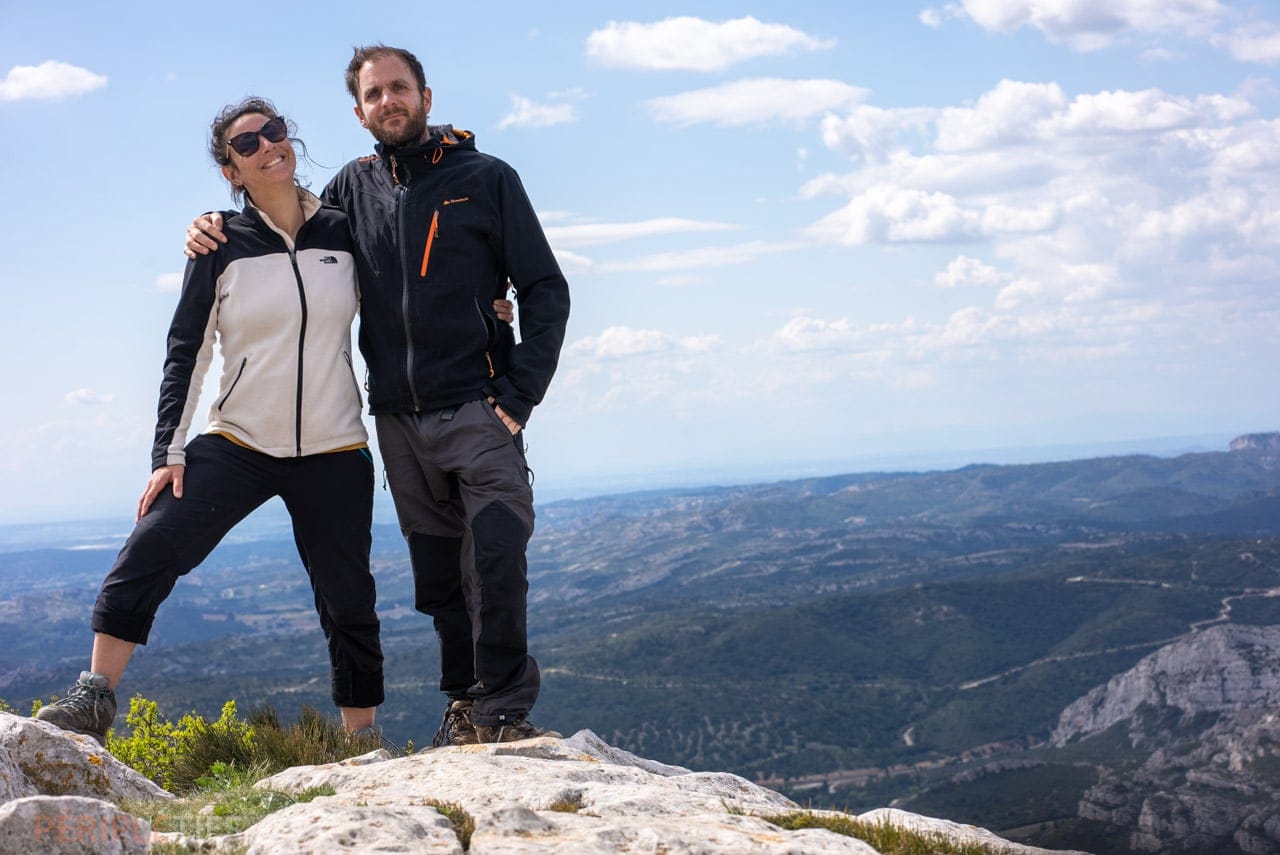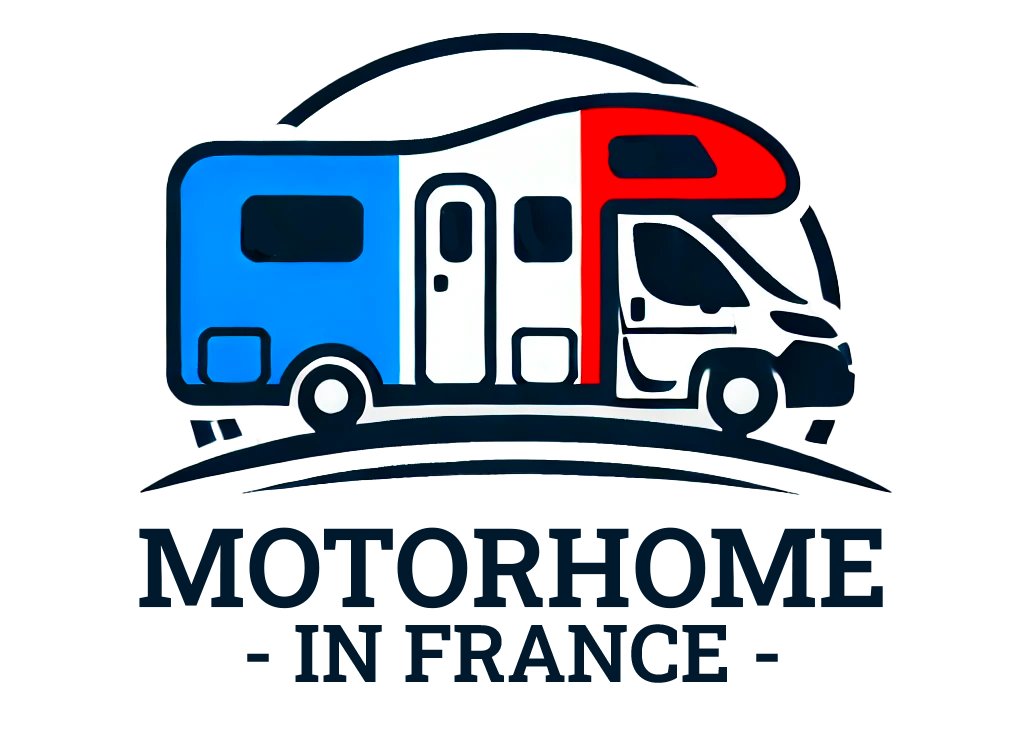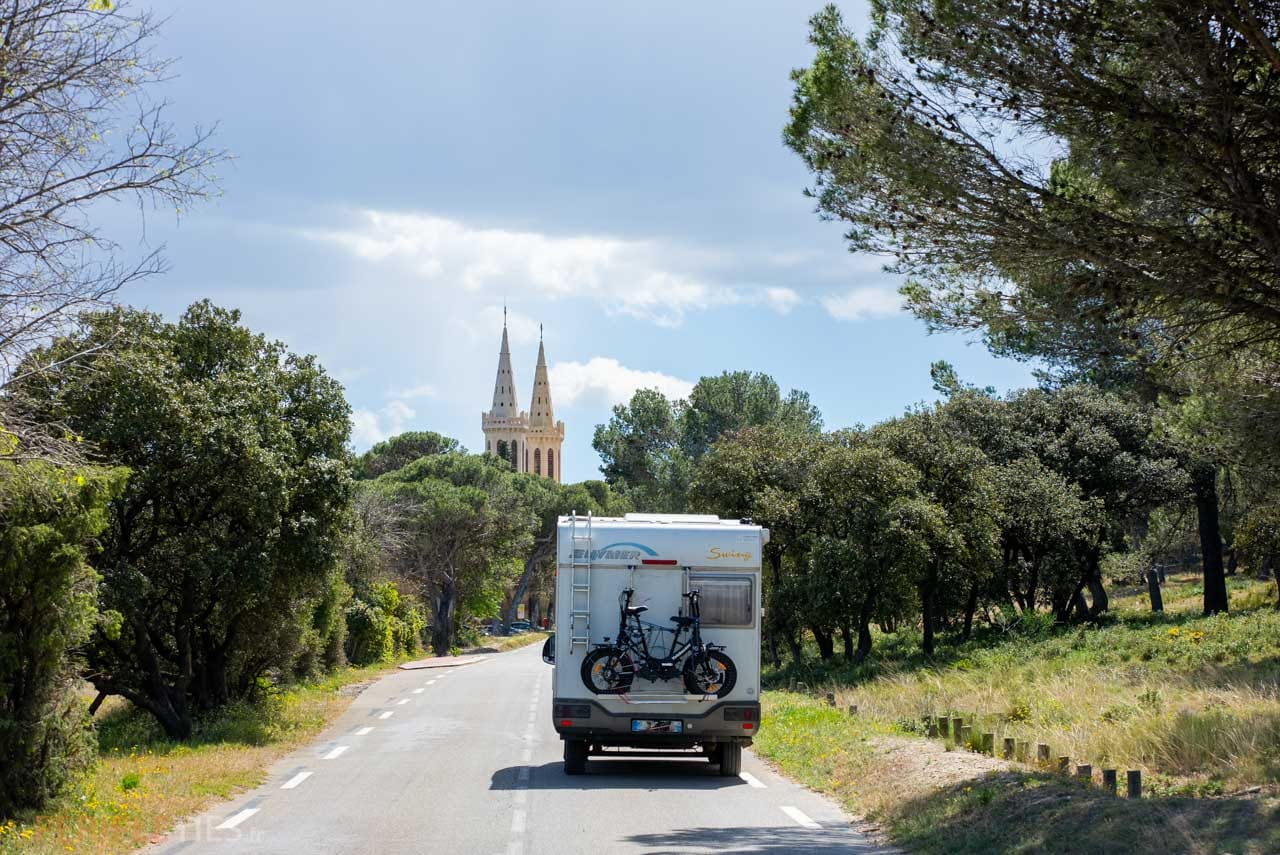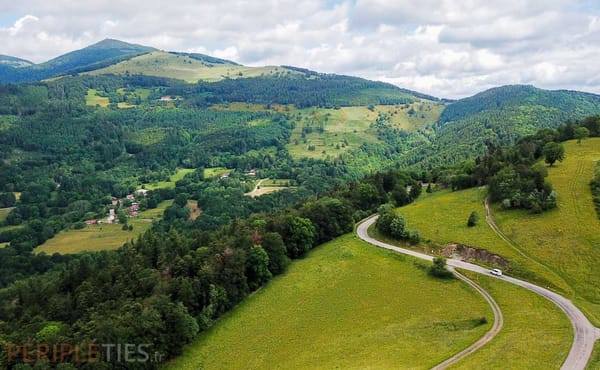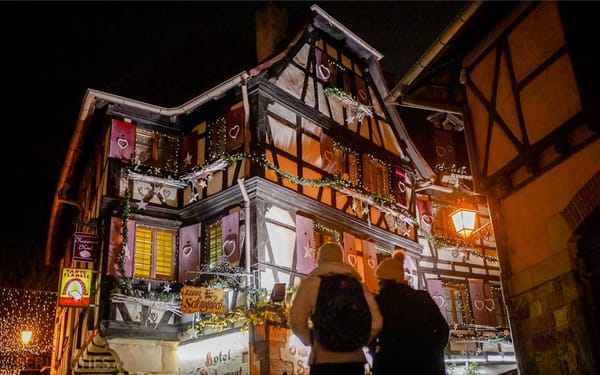Where are the Alpilles?
The Alpilles is a small, wild and unspoilt mountain range in south-east France. Located in the heart of Provence, in the Bouches-du-Rhône department, this area stretches between the Lubéron and the Camargue (from southern Avignon to Arles, via the Crau plain).
Referred to as the ‘little Alps’, this area owes its name to its range of very low limestone mountains (maximum altitude 498 m).
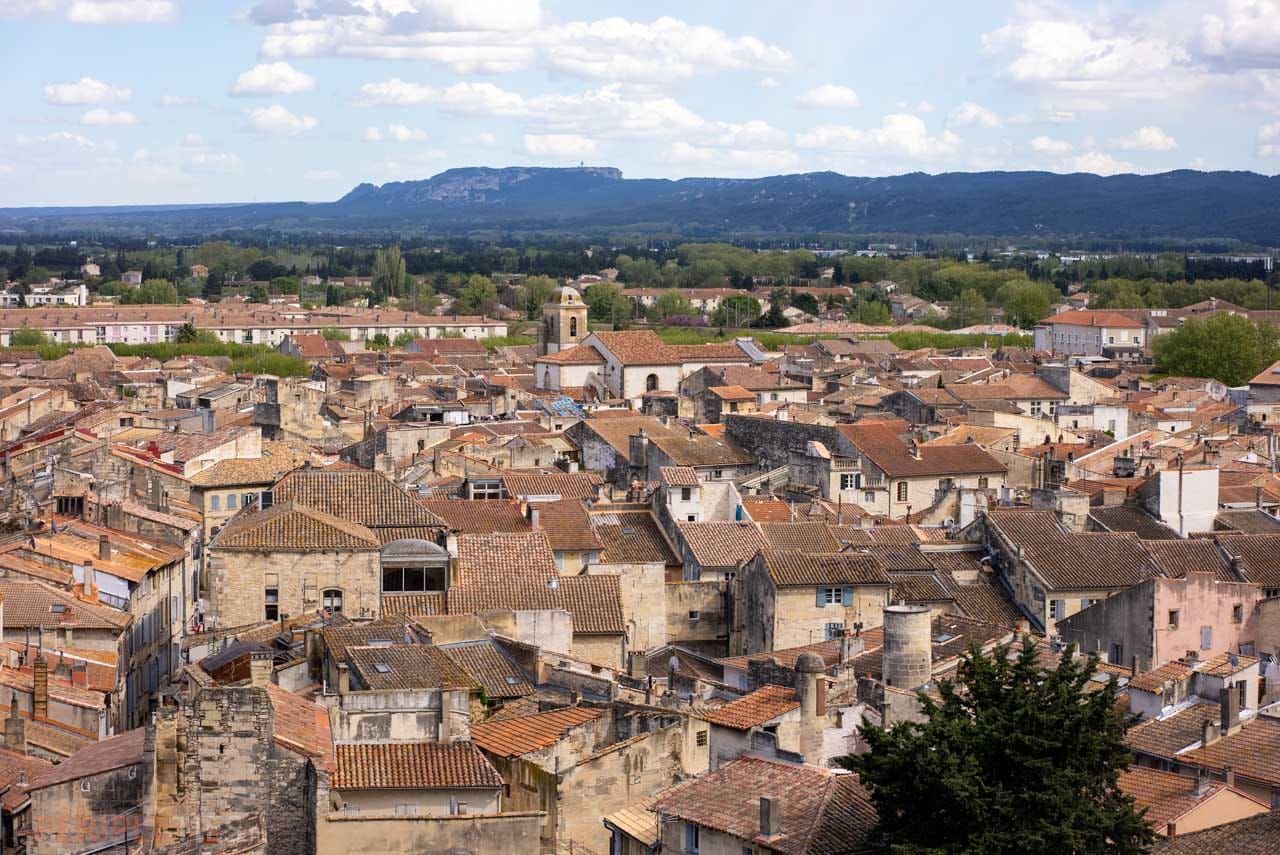
What can you do in the Alpilles mountains?
The Alpilles offers a wide range of things to discover. Lovers of heritage and old stones will be delighted, as will those who enjoy unspoilt natural landscapes and hiking.
Imagine a small mountain range covered in garrigue, small pine and holm oak forests overlooking fields of olive trees as far as the eye can see...
Imagine landscapes bursting with spring flowers, just like the canvases of one of the most famous painters...
Vincent Van Gogh painted over 100 canvases here during his convalescence (see chapter on the Cloître Saint-Paul).
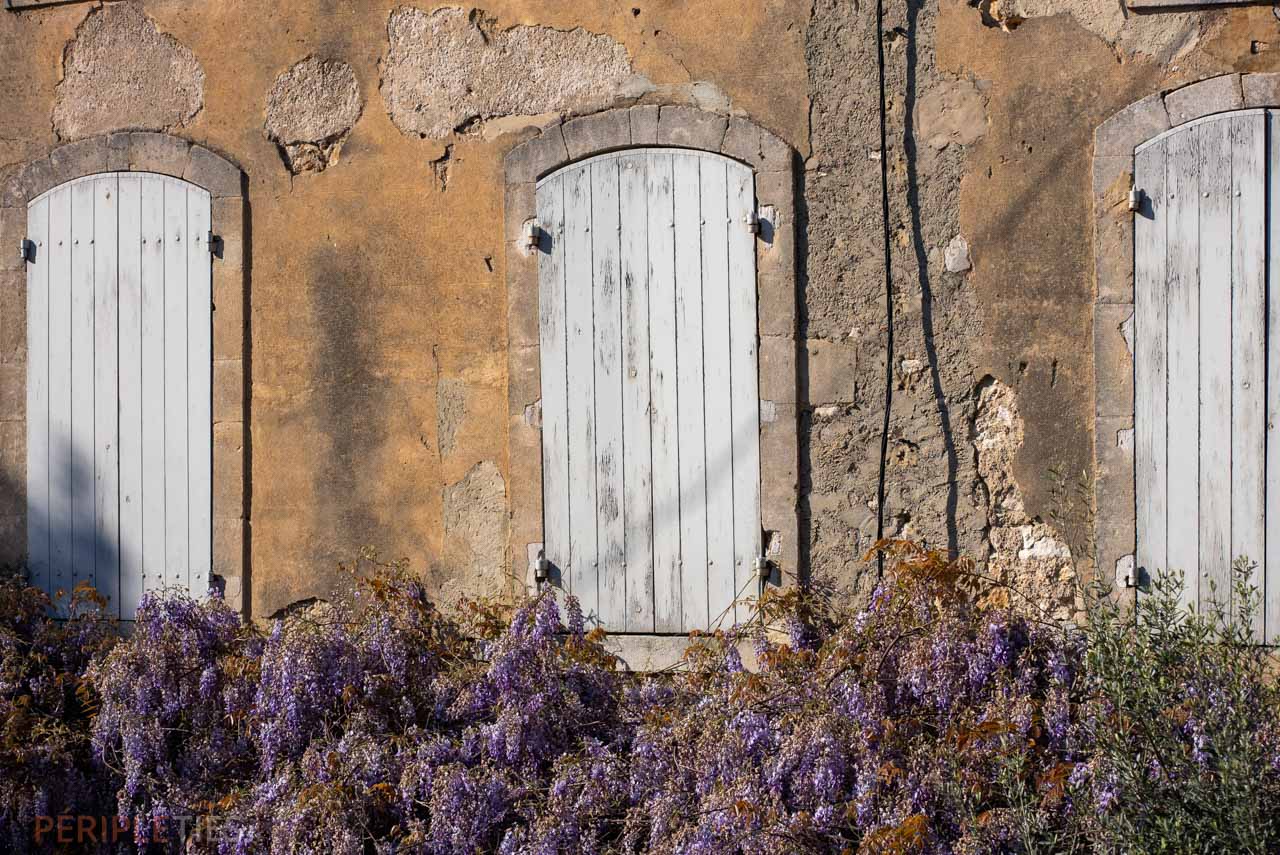
Olive oil and PDO Baux-de-Provence wine
The best way to explore this area is to take the small, steep roads that regularly open onto olive groves or the Baux de Provence PDO vineyards...
You'll also discover some real picture-postcard landscapes as you walk along the massif. That's how you'll get the most out of this Provence, which has preserved its character and traditions.
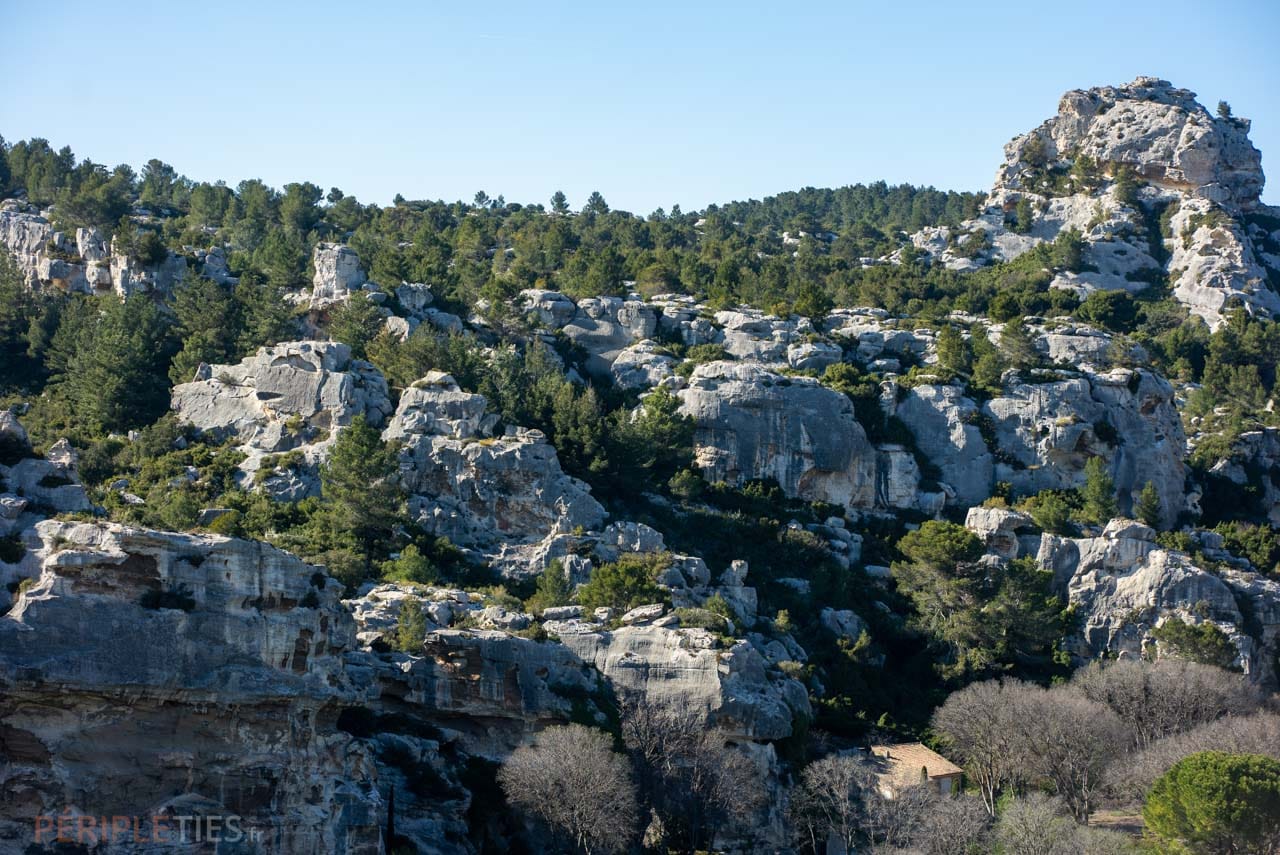
The Alpilles Transhumance Festivals
Speaking of traditions and folklore, the "Fêtes de la Transhumance" in the Alpilles, celebrated every April, is just one example.
Of course, you may hear here and there that ‘peoplisation’ and property speculation, particularly on wine estates, are tending to take away from its original spirit.
But in our opinion... the Alpilles is far from having capitulated yet!
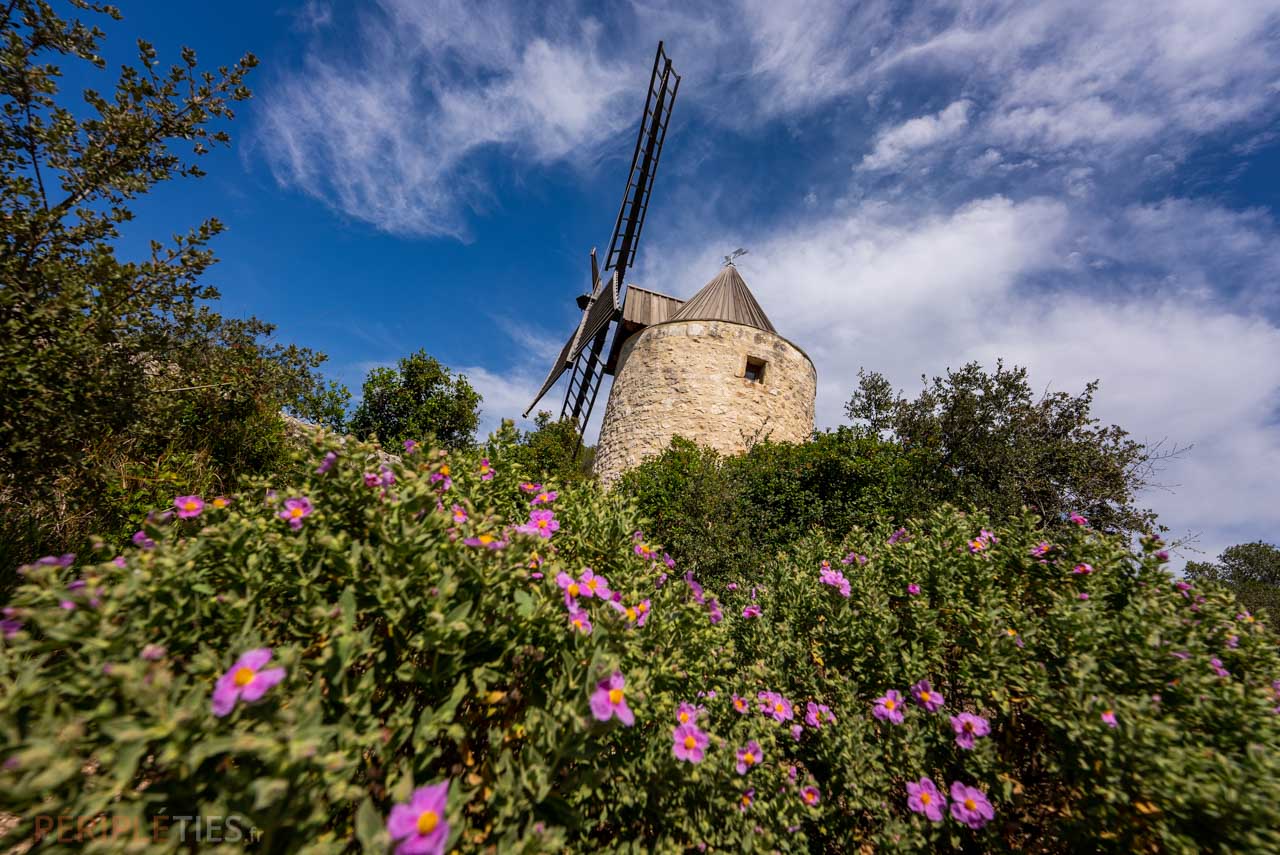
When to go to the Alpilles?
We simply loved exploring the region and visiting the Alpilles in April, as we do in many other French destinations.
It's the time when the fine weather is setting in, but it's not yet too hot. Nature is still green, the trees are in bloom and there aren't too many people around.
What do we call the inhabitants of the Alpilles?
As the Alpilles is not a region in the strict sense of the word, but rather an area formed by the massif, the inhabitants of the Alpilles are usually referred to by their home town.
The inhabitants of Maussanne-les-Alpilles are called Maussanais. The inhabitants of Les Baux-de-Provence are called Baussencs and Baussenques. Those of Saint-Rémy de Provence, the Saint-Rémois. Here are a few names to help you shine in society. 😄
Must-see sites for a few days in the Alpilles
Among the must-sees, the Alpilles inevitably brings to mind the village of Les Baux-de-Provence, with its incredible medieval fortress and the Carrières de Lumières, Saint-Rémy-de-Provence, the ancient site of Glanum and the typical villages of Maussane-les Alpilles, Mouriès and Fontvieille.
Where can I find a map of the Alpilles?
You'll find this tourist map in pdf format on the PNR des Alpilles website, as well as a number of useful brochures in the local tourist offices, particularly in Saint-Rémy de Provence, where you'll also find the Maison du Parc.
We've also included our 100 km motorhome itinerary on the Google Map below and in this article.
Motorhome or van tour: how to visit the Alpilles?
The Alpilles is one of those parts of Provence that's not lacking in charm or authenticity and where motorhomes still have their place, provided, in our opinion, that you avoid the high season! And that's exactly what we did.
Parking and campsites in the Alpilles
There is, however, only one parking and service area at Fontvielle, near the Moulin Daudet (€10 for 24 hours, €2.50 for 10 minutes of water).
This one is perfectly designed, sheltered by pine trees. The only drawback is that it is impossible to gain access to the dumping area without paying the parking fee.
The other facilities are campsites in the Alpilles with motorhome pitches, but there are also alternatives!
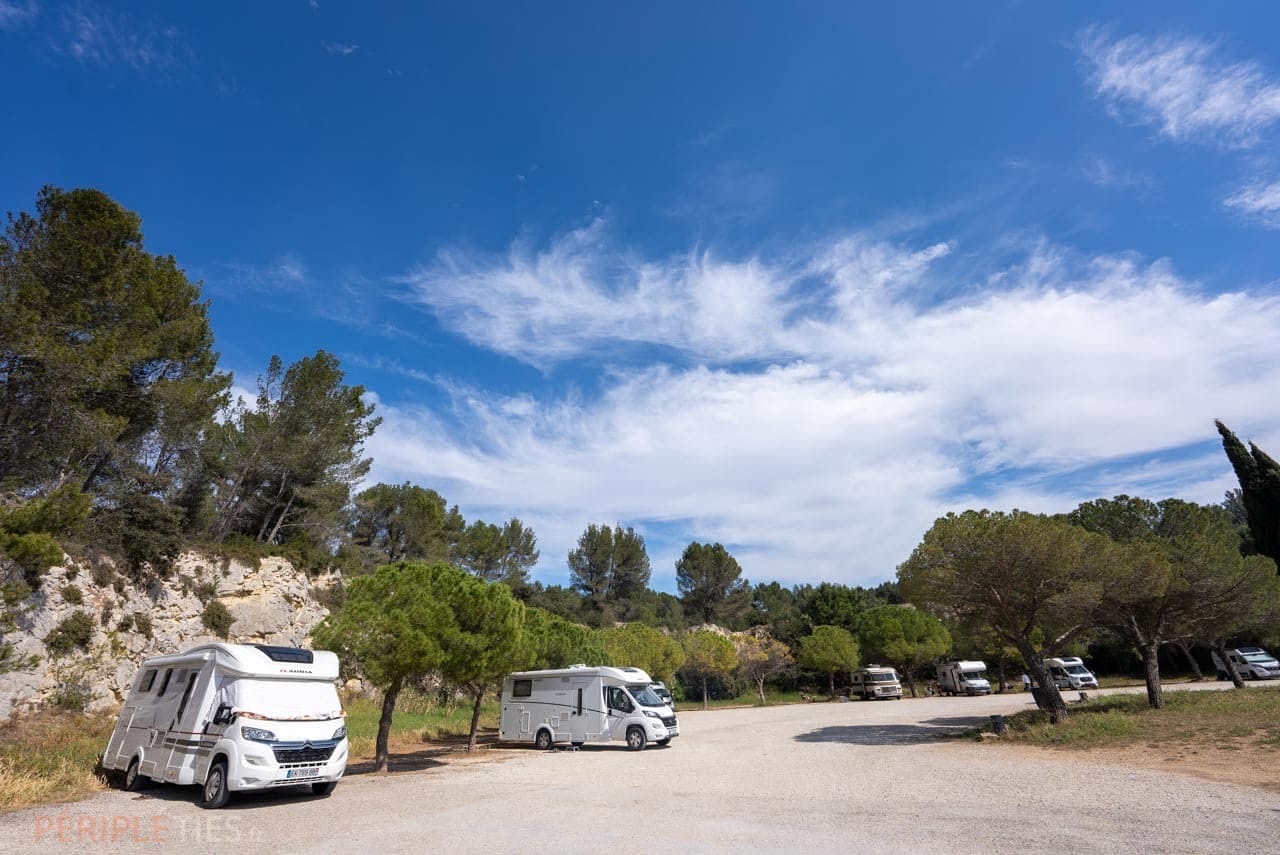
Our one-week itinerary in the Alpilles
Our journey begins in Tarascon, a must-see town at the gateway to the massif, in the north-west. This is a town steeped in legend, the story of a monster called ‘la Tarasque’, who used to occupy the surrounding marshes and terrify the population...
The Tarasque festival takes place every year in June and is a UNESCO World Heritage Site. They celebrate both the creature and Sainte Marthe... who apparently succeeded in bringing down the fearsome beast!
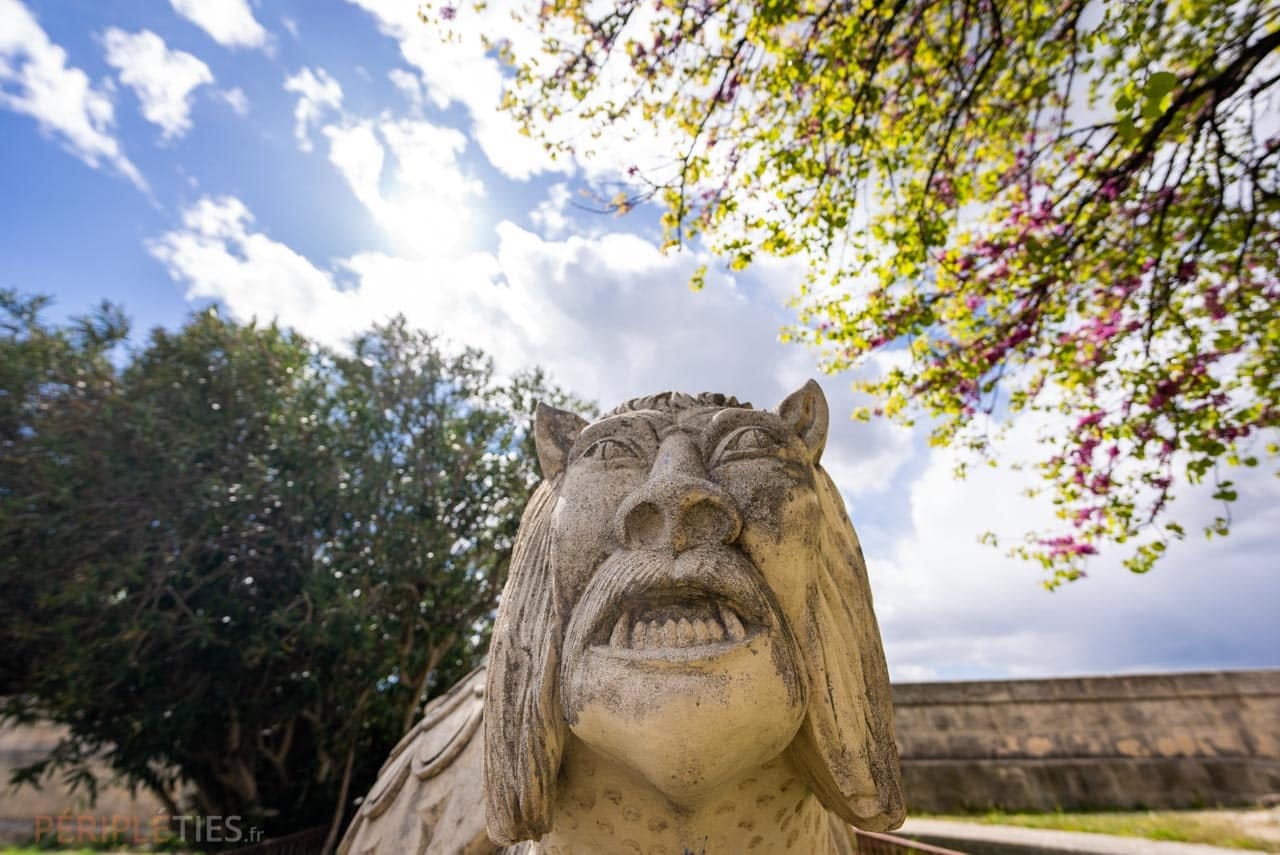
Tarascon Castle, a foretaste of the Alpilles Park
These festivities are one of the main reasons to come to Tarascon. You can also visit the Royal Collegiate Church of Saint-Marthe, listed as a historic monument since 1940.
Above all, don't miss a visit to the impressive medieval castle of King René (Count of Anjou), which stands on the Rhône. It rivals in stature the castle of Sedan, which we visited on our trip to the Ardennes, along the Meuse.
We recommend a visit (€8) to discover its 31 rooms and, above all, its main attraction: the breathtaking view from the castle's upper terrace! On the town side, you can already see the start of the Alpilles mountain range.
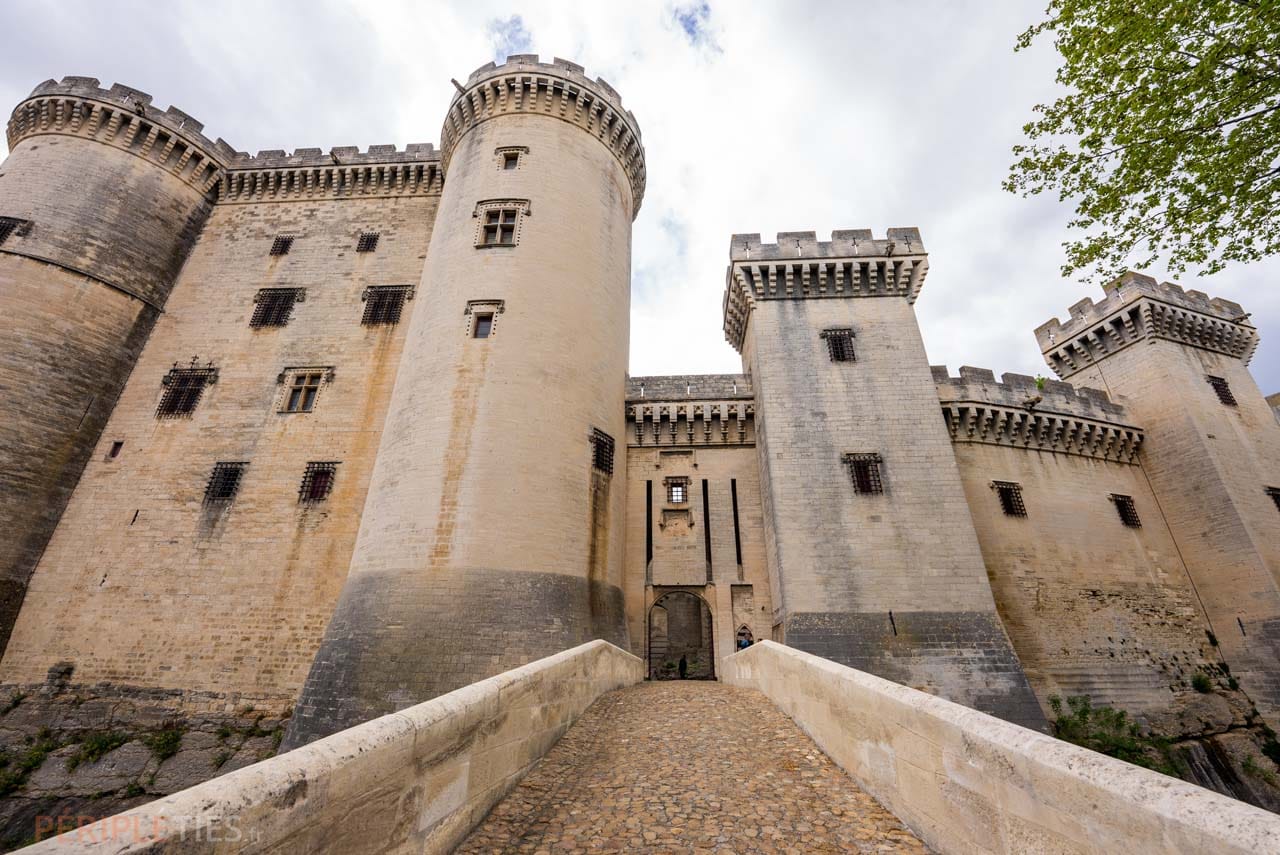
Motorhome parking in Tarascon / Beaucaire:
- Motorhome area Beaucaire, 3 Quai de la Paix nord (Port de Plaisance). 7 to 8 pitches. Water, electricity and drainage. Access to terminals with tokens (€2).
- Camping Le Tartarin, located at the foot of the Château de Tarascon: https://www.campingtartarin.fr/
- Private land in Beaucaire: secure motorhome pitch at Marie-France's with water and electricity. From €12.
- Camping with locals in Tarascon: private pitch for caravans and motorhomes at Eric & Karima's with swimming pool, electricity, water. Tents can be borrowed. From €10.
- Camping with locals in Beaucaire: shaded pitch for vans and motorhomes at Claire's with swimming pool, surface area of 2500 m², water, electricity, internet... From €12.
Saint-Michel de Frigolet Abbey
Taking the side roads that wind through the hills of the Montagnette, we come to the Abbey of Saint-Michel de Frigolet, another must-see in the Alpilles.
It's a building that doesn't quite resemble the many abbeys you can see on a trip to Belgium. It can be recognised in the distance, thanks to the characteristic towers of the cathedral, Notre Dame de Bon Remède (No, this isn't Disney Land!).
It was in this building, in the shade of the Aleppo pines and in a setting of extreme serenity (out of season) that Frédéric Mistral, winner of the Nobel Prize for literature and a local boy, studied as a child.
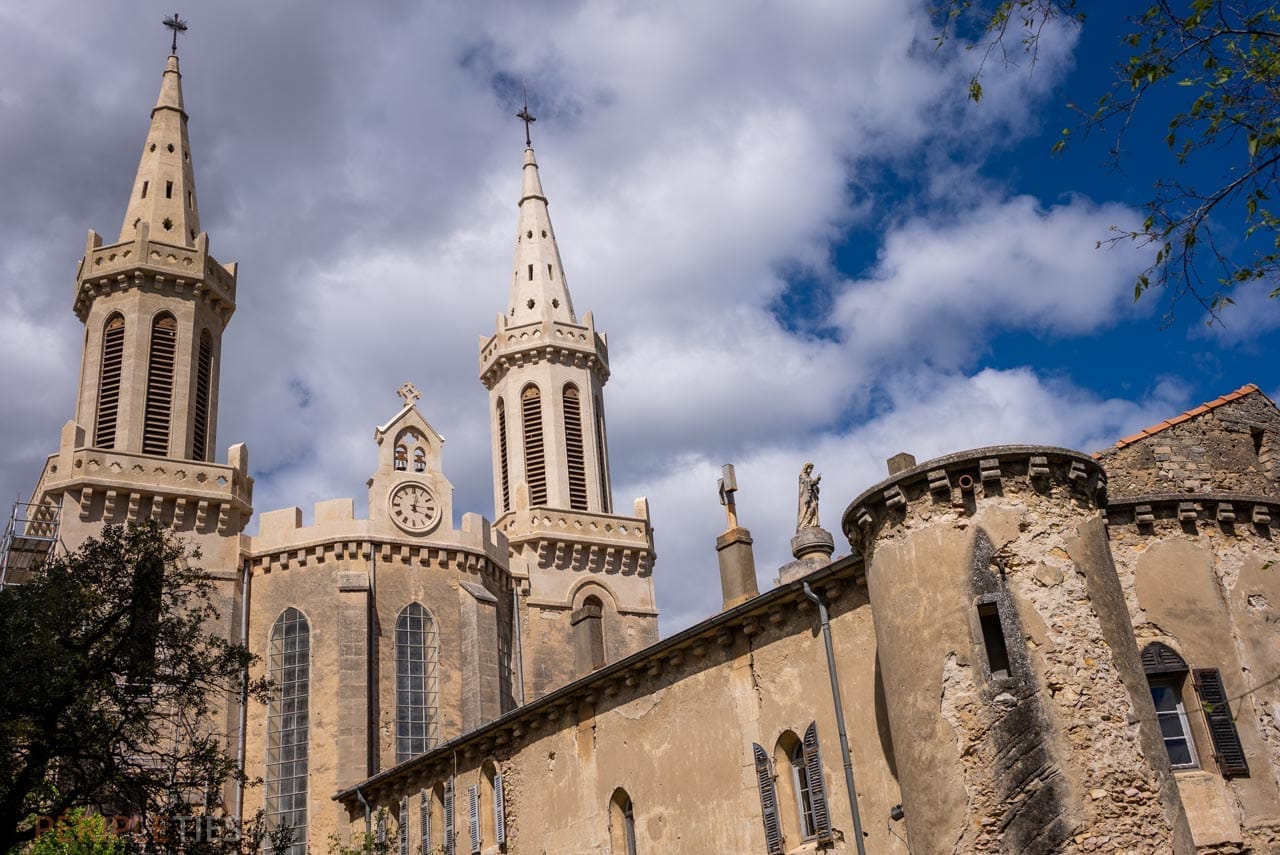
Parking and restaurant at Frigolet Abbey
A large car park is available and the visit is free (please note: motorhomes are not allowed to park from 10pm to 6am; alternative is to camp with a local in Graveson, 6 km away).
You can even eat at the restaurant de la Treille, which we tried out and which serves traditional dishes and products from the abbey (beer, honey, olive oil and Frigoulet liqueur).
A (slightly expensive) daily menu is available (starter/main course/dessert €24; main course €16), with an additional €4.50 for a craft beer. A word of advice: make the most of the superb terrace for lunch!
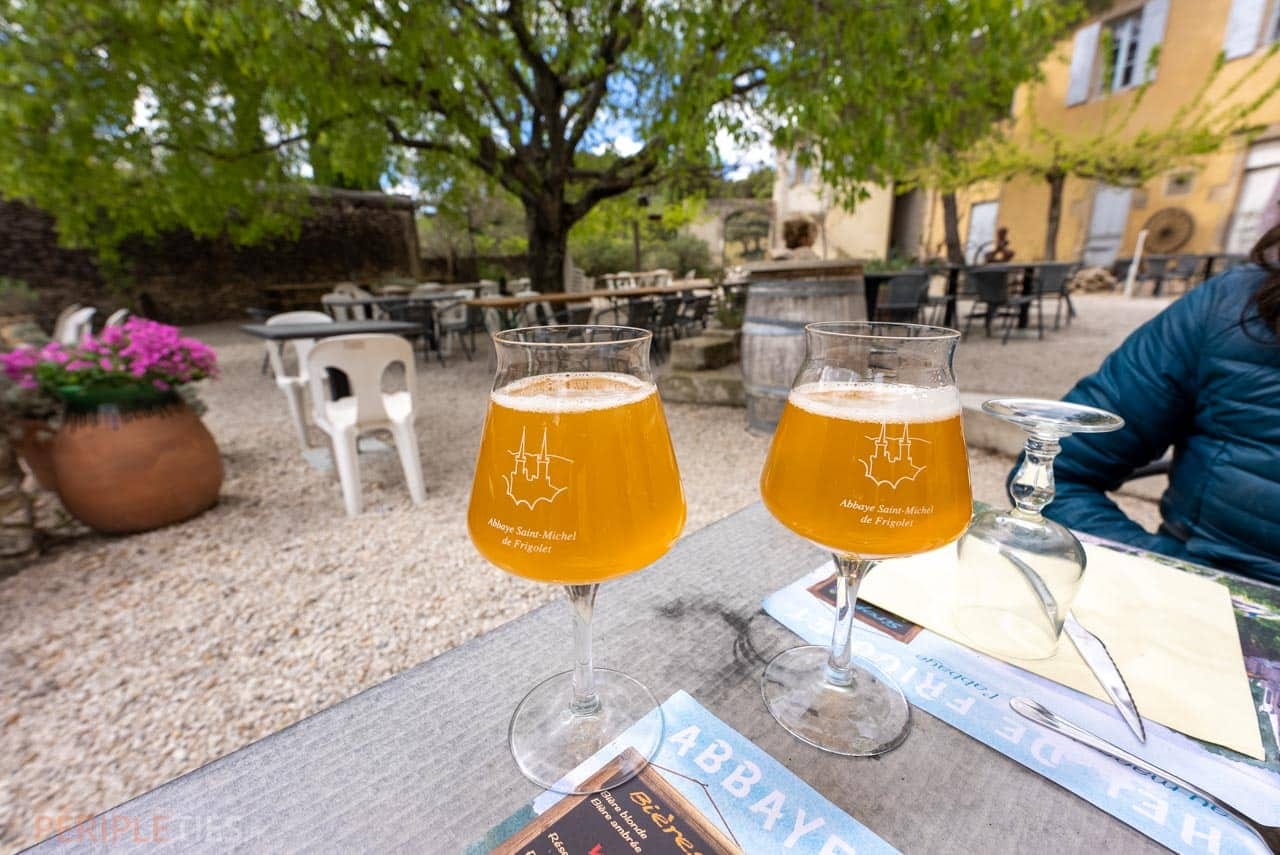
Discovering the Alpilles Regional Nature Park
We'll then head back to the Alpilles Regional Nature Park.
Created in 2007, it encompasses the massif, the town of Saint-Rémy de Provence, Les Baux de Provence and typical little villages such as Fontvieille, Mas-Blanc-des-Alpilles, Maussanne-les-Alpilles, le Paradou, Mouriès, Eygalières and Aureille.
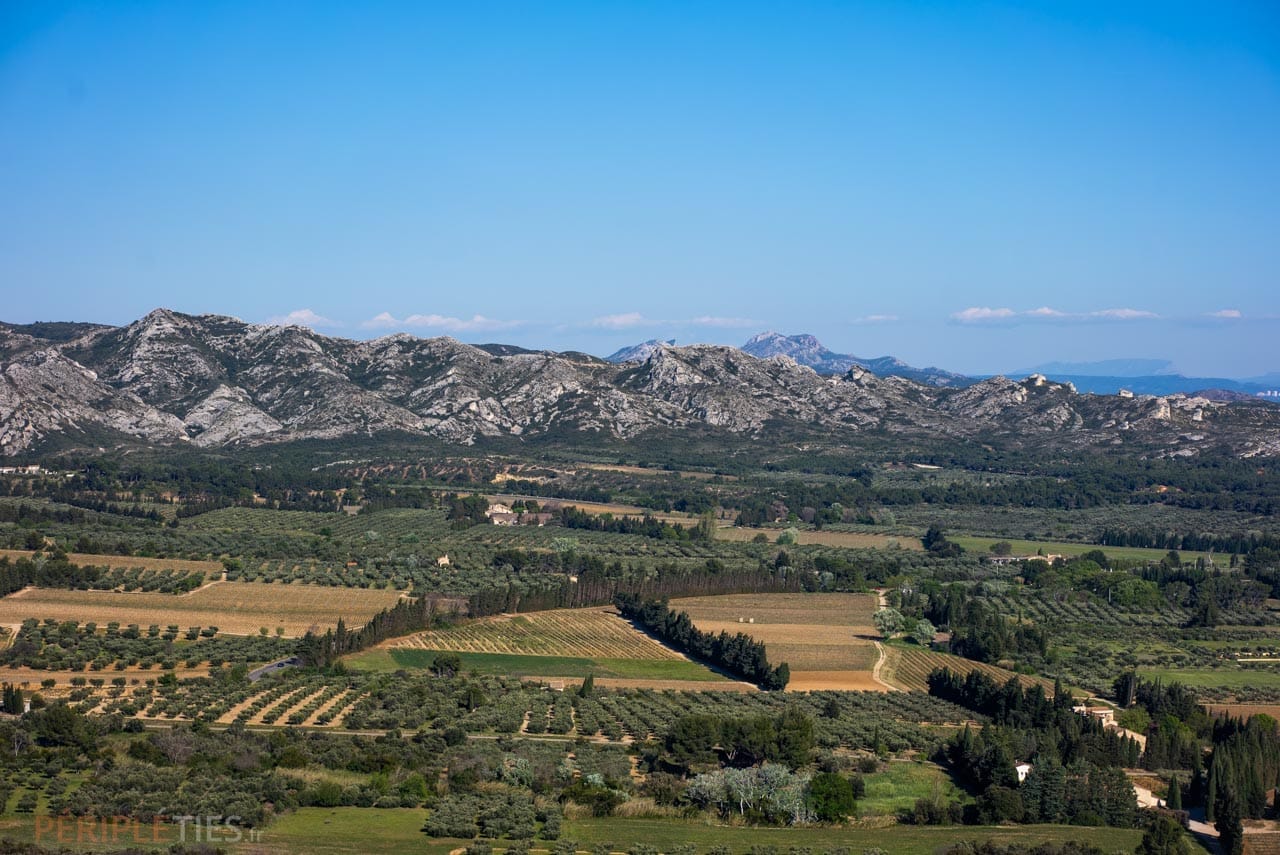
What to do in Saint-Rémy-de-Provence?
We begin our tour of the Alpilles Regional Nature Park in Saint-Rémy-de-Provence.
It's best to park in the car park at the entrance to the town and do everything on foot. The town, considered to be the capital of the Alpilles, is in any case the best known and attracts the crowds in summer.
It's a bit like ‘the place to be’, we're not going to lie! But early in the tourist season, it's a very pleasant town, where boutiques, artists' studios and art galleries flourish.
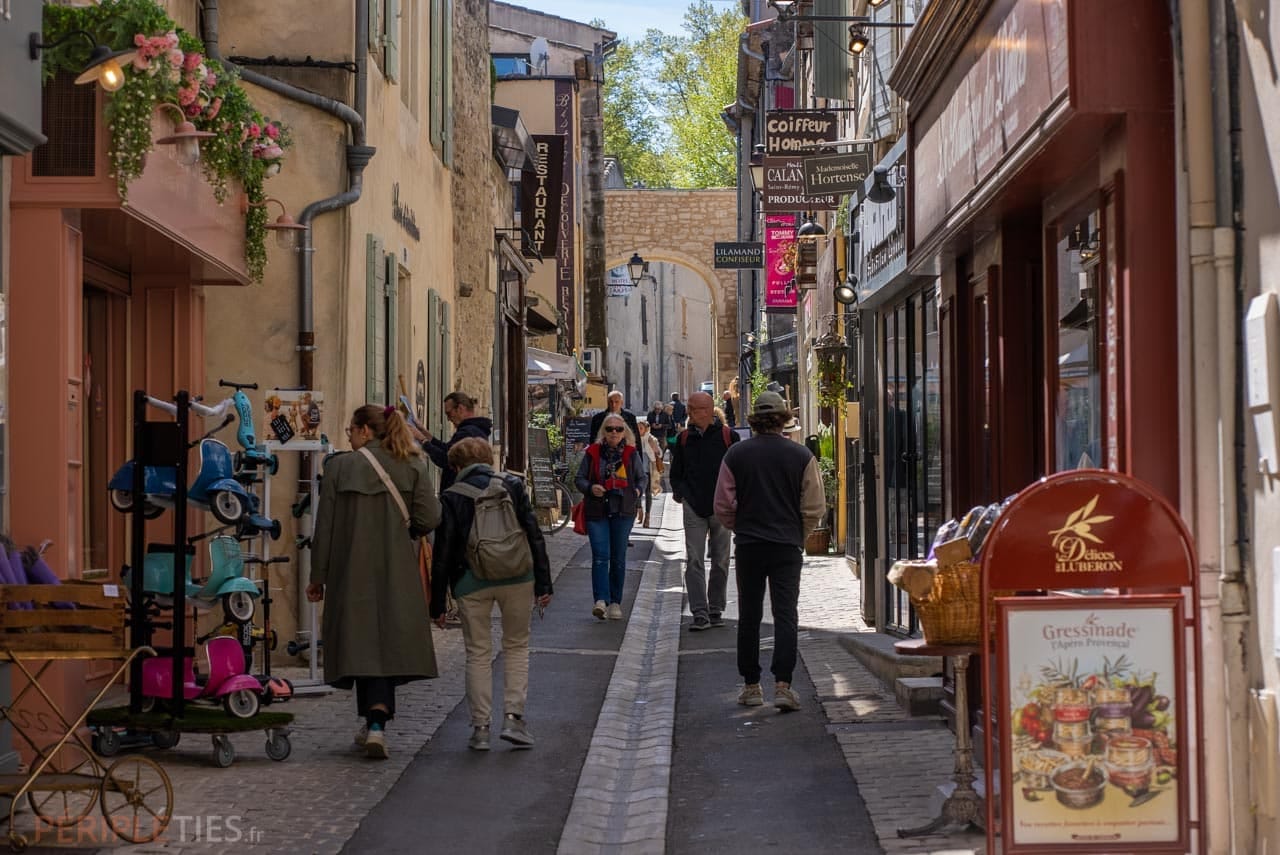
Visit the Alpilles Museum, in the old town
Above all, enjoy the typically Provençal atmosphere of the old town and its most emblematic buildings (Hôtel de Sade, Musée des Alpilles, Collegiate church of Saint-Martin, Musée Estrine).
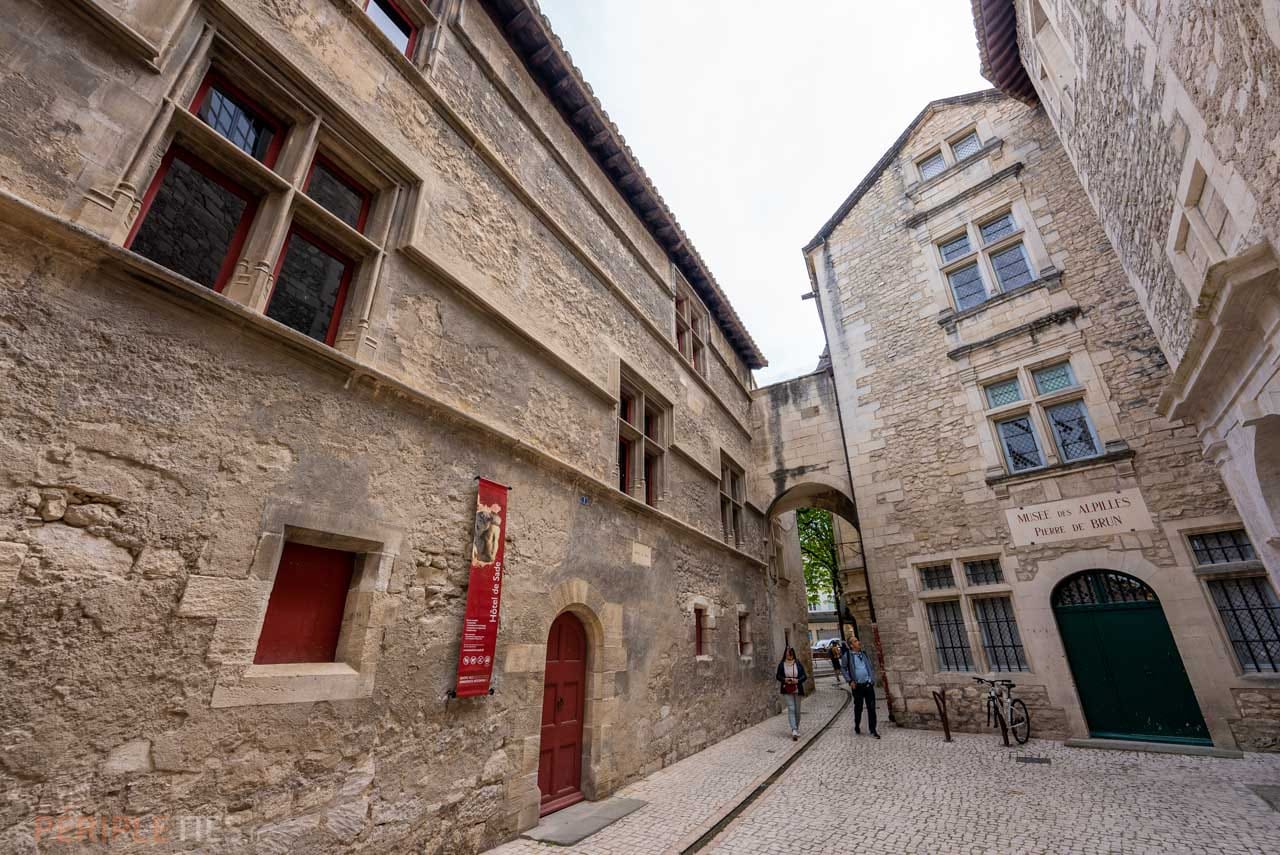
Where to eat in Saint-Rémy-de-Provence?
There's no shortage of places to eat in Saint-Rémy-de-Provence.
We ate at the Maison Favier, in the heart of Saint-Rémy-de-Provence, where we found a warm welcome, with dishes (including vegetarian) ranging from 16 to 22 euros and tasty desserts (8 euros). The food and setting are very pleasant, and we recommend it! However, there is no menu.
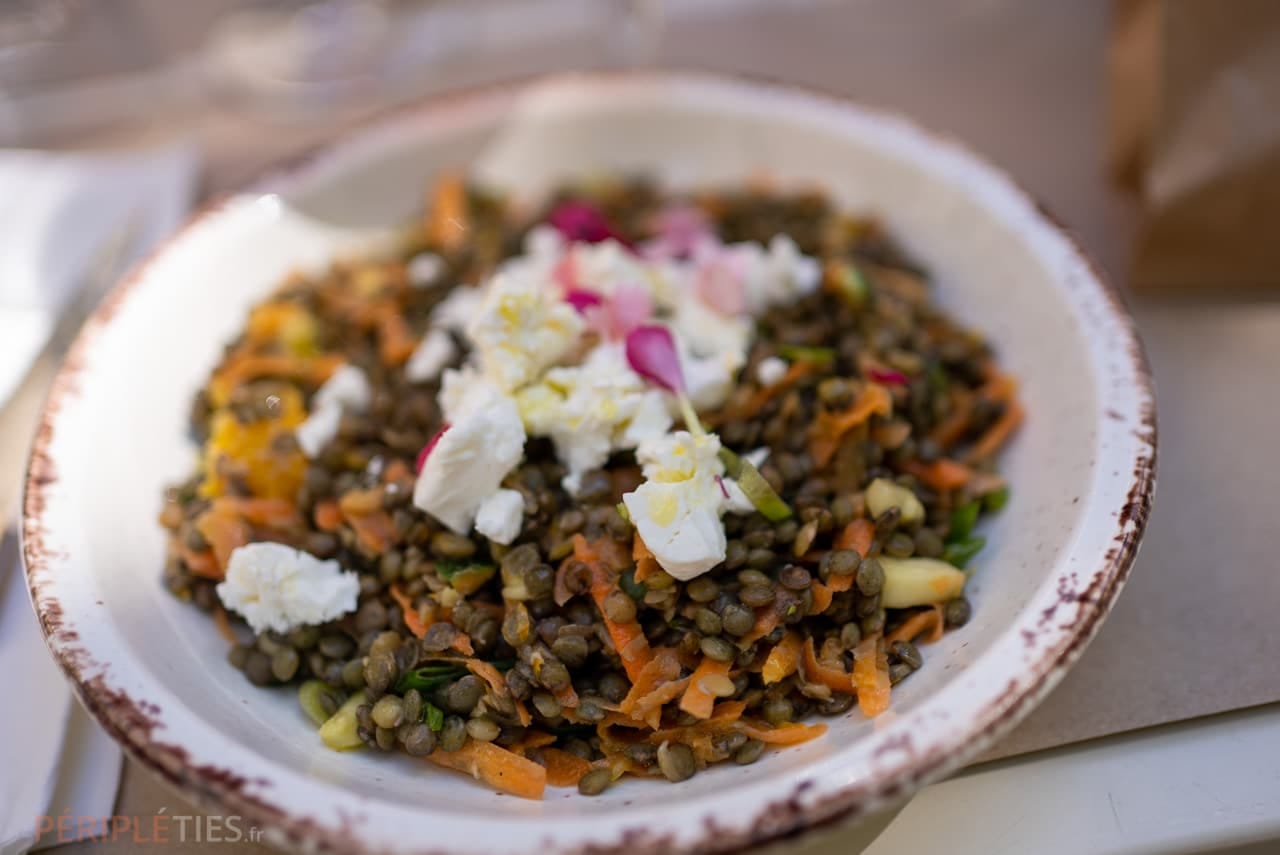
A Van Gogh tour to the Saint-Paul cloister
1 km from the centre is the monastery of Saint-Paul-de Mausolée, where Van Gogh was interned at his own request after cutting off his ear...
It was also here that he painted much of his work. A path leading from the Musée Estrine is dedicated to the painter. It's a shame it runs alongside the busiest road!
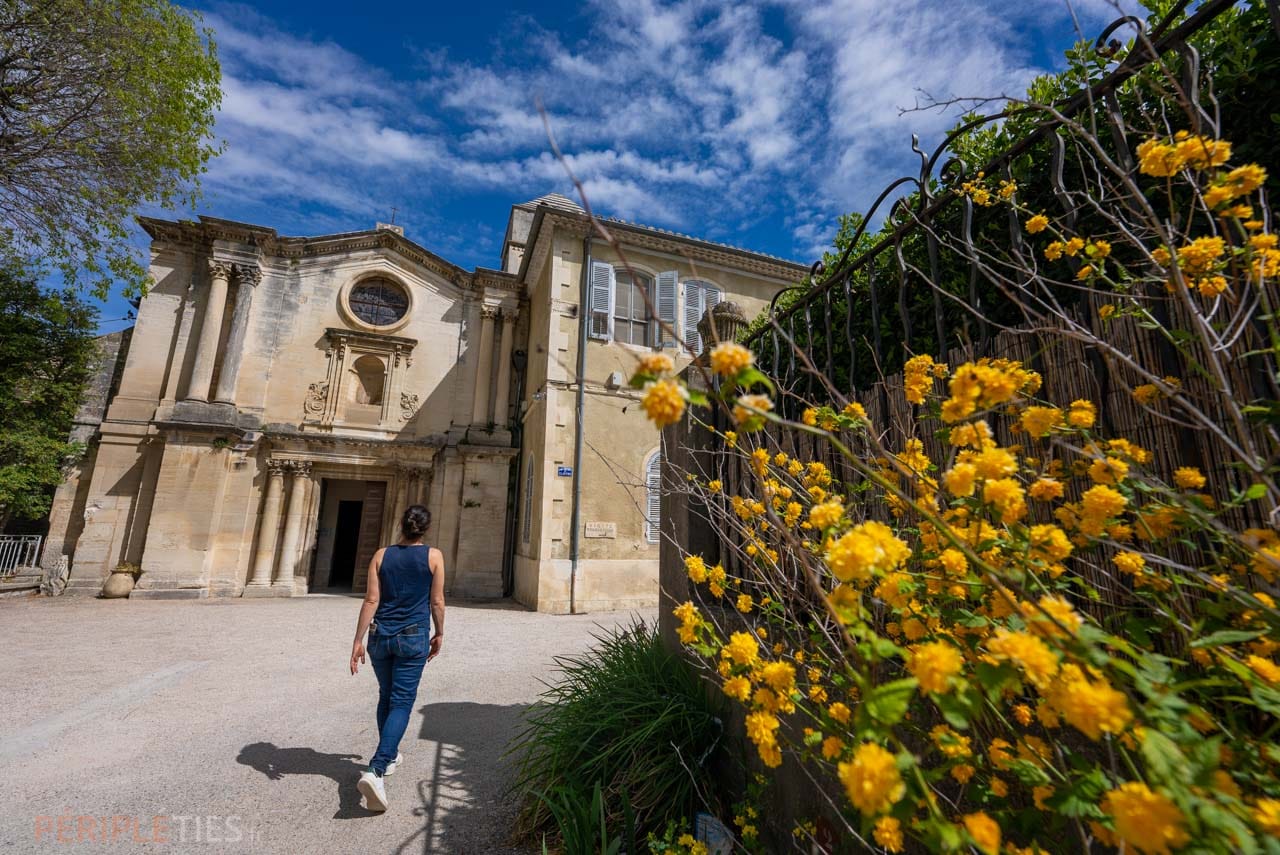
The Saint-Paul-de-Mausole Monastery
The Saint-Paul-de-Mausole monastery is a remarkable edifice, still faithful to its vocation as a home for psychiatric patients.
Listed as a historic monument, part of the cloister can be visited (entrance fee 7 euros), including the room occupied by Van Gogh during his year-long stay.
The site is magnificent, but the format of the explanations leaves something to be desired if you don't have an audioguide (€3).
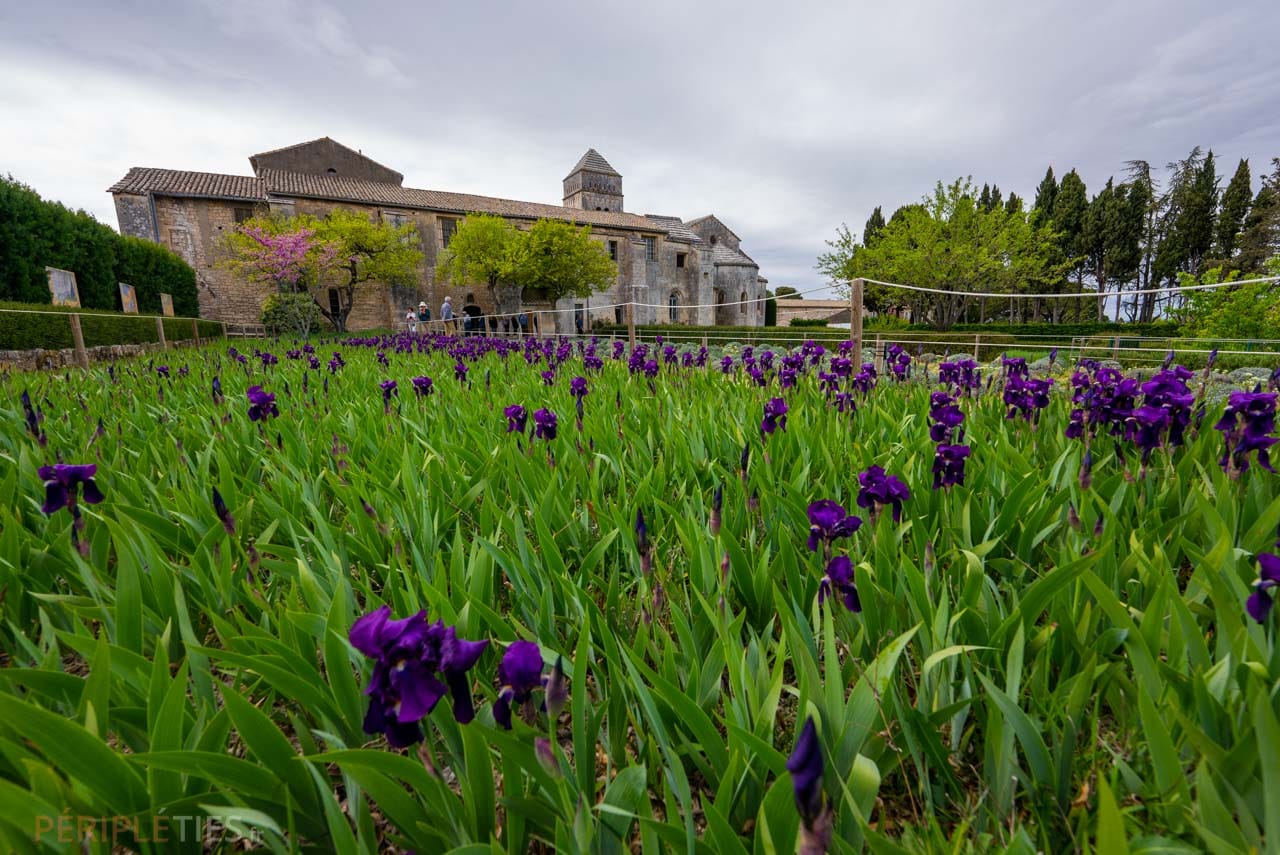
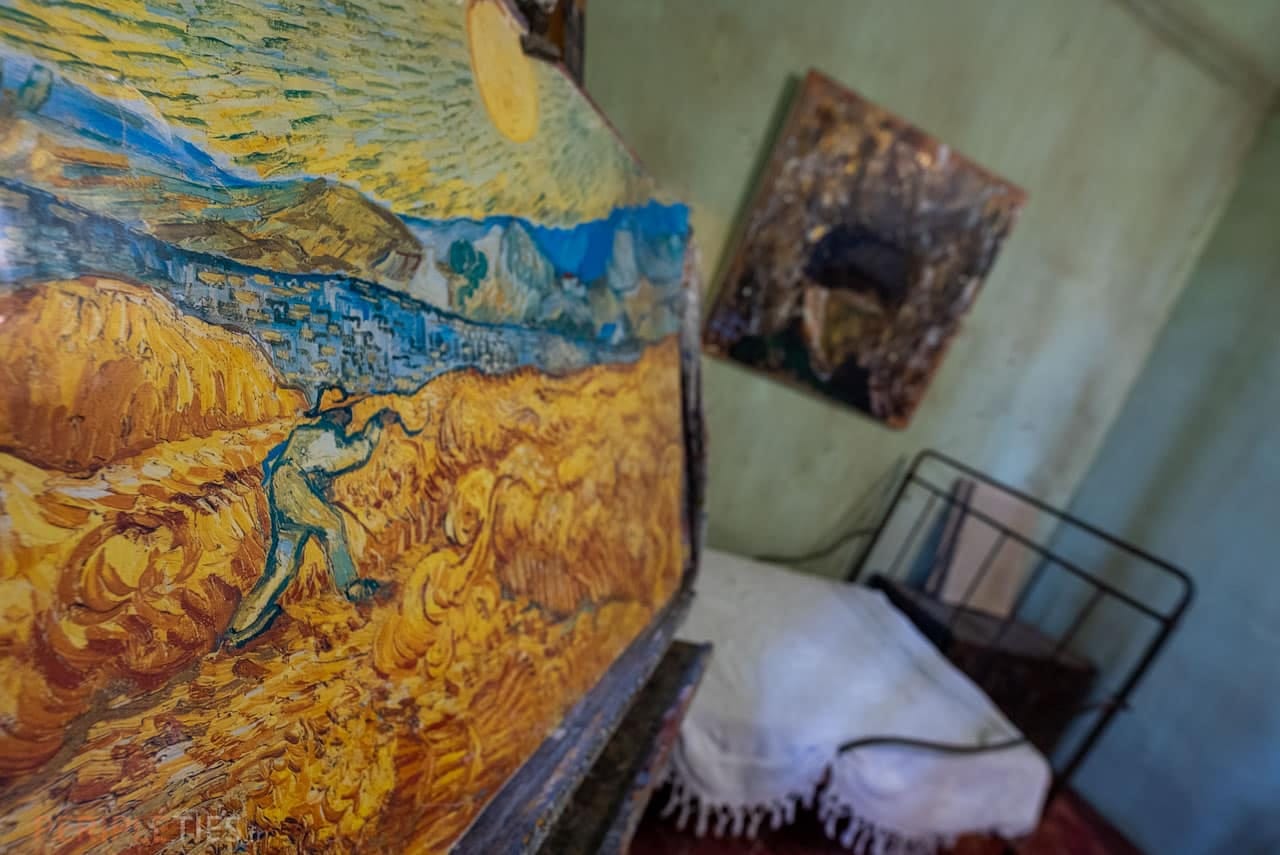
The archaeological site of Glanum
Opposite the Saint-Paul cloister is the ‘Antiques’, an archaeological site featuring the Triumphal Arch and the Mausoleum of Julius. Right next door, you can visit Glanum, the remains of a Gallic city with Greek and then Roman influences.
The thermal baths, forum, columns and temple give a glimpse of the city through the ages. It's always quite breathtaking, but when it comes to archaeological sites, nothing beats the archaeological site of Merida, one of our top discoveries in Estemadura (Spain)!
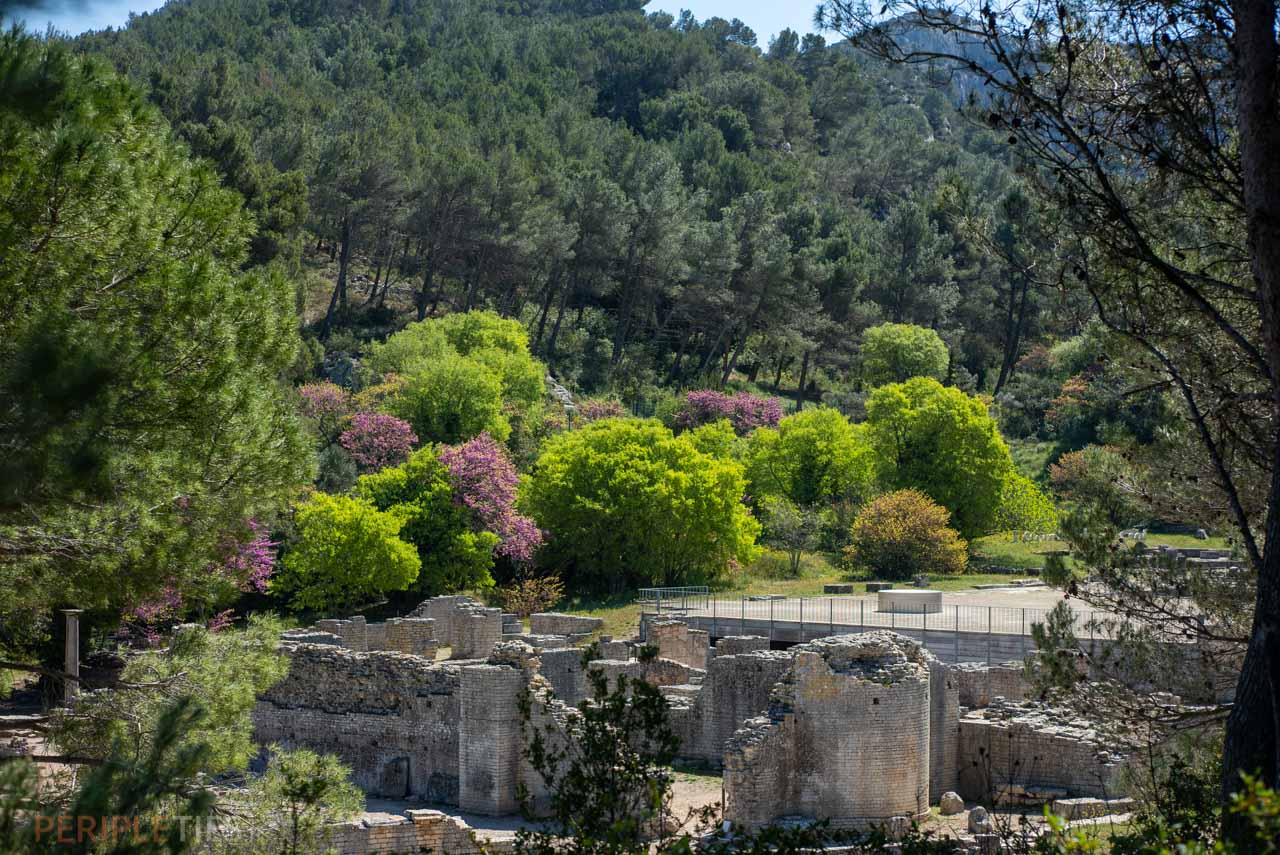
Flowers and spring in the Alpilles massif
But above all, the setting of the ruins, at the foot of the Alpilles massif, is simply marvellous.
Especially if, like us, you're lucky enough to see it in spring when the trees are in bloom. The excavated artifacts are on display at the Hôtel des Sade, in Saint-Rémy de Provence.
Entrance to the Glanum site costs €8, plus €4 for unsupervised parking.
To avoid queuing at the ticket office (especially during the tourist season), we recommend you book your ticket for Glanum online: you'll save time and pay no more.
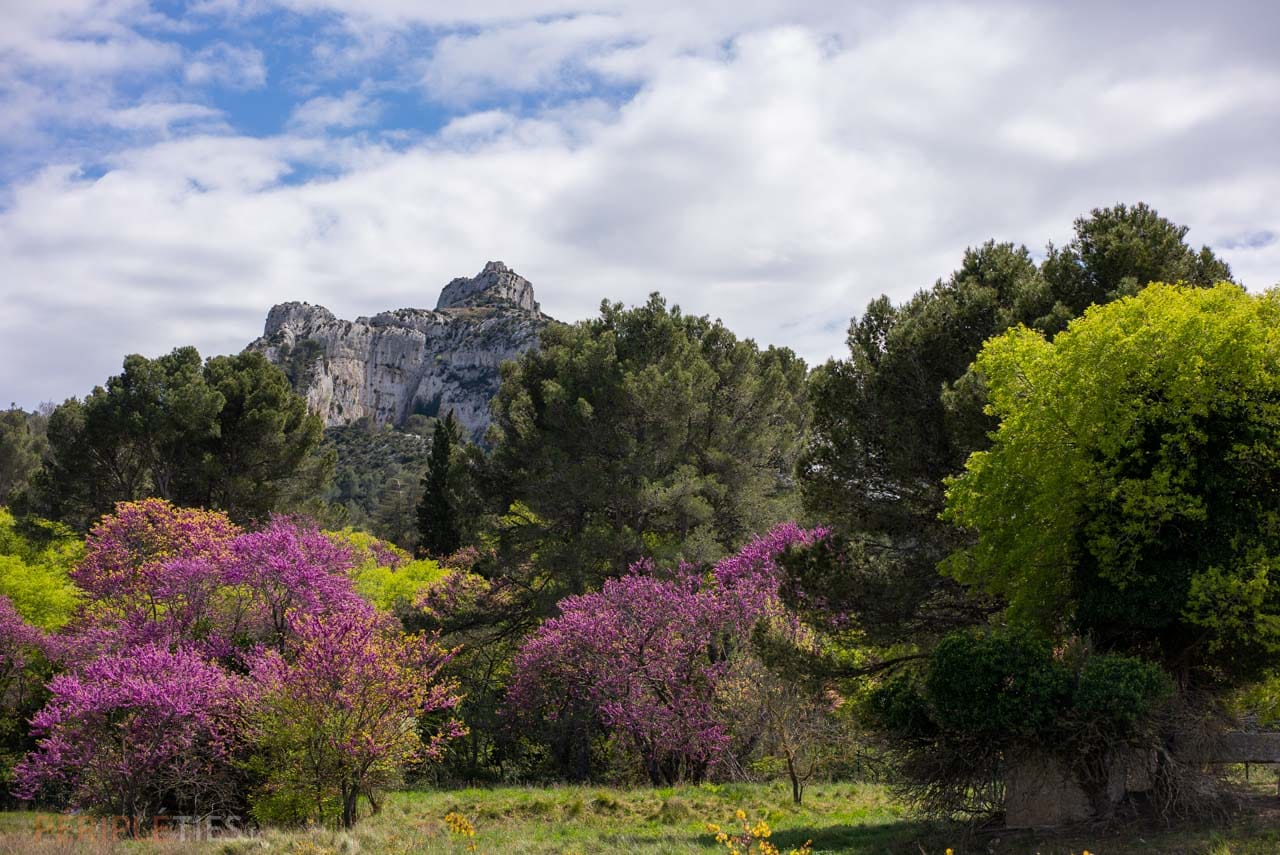
The village and castle of Les Baux-de-Provence
We continue on our way to another famous hilltop village. One of those that look like an open-air museum, with its maze of stone streets and flourishing tourist boutiques and artists' galleries.
Les Baux-de-Provence can be seen in the distance on the Vallée des Baux wine route (from Saint-Rémy to Fontvieille), thanks to the castle that blends into the rocky spur on which it sits.
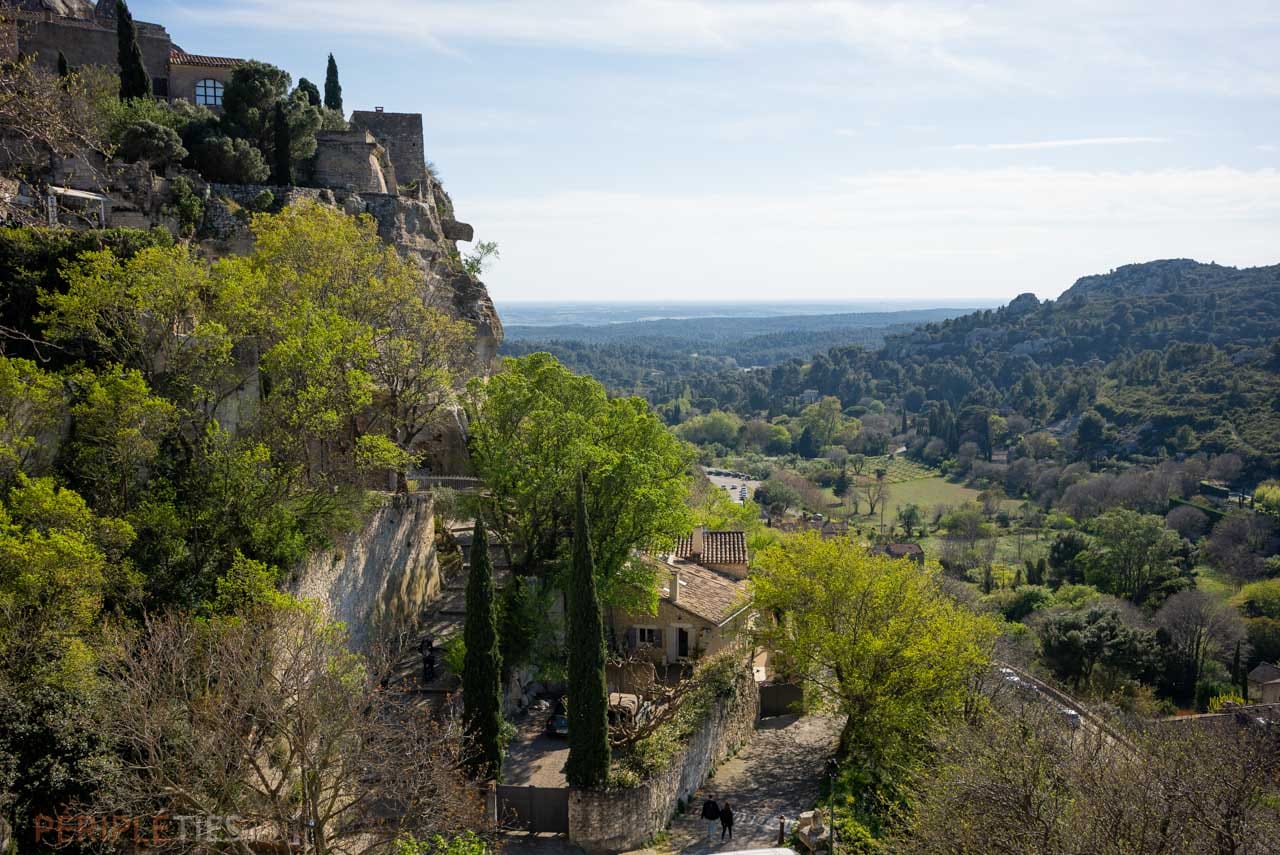
It's undeniably... beautiful, even if you have to admit that these tourist villages always lack a bit of soul...
The panorama from the terrace and the castle, on the other hand, is breathtaking. You can see the entire Alpilles mountain range, including the Tour des Opies, the highest point in the massif (498 m), the Crau plains and even the Camargue in the distance!
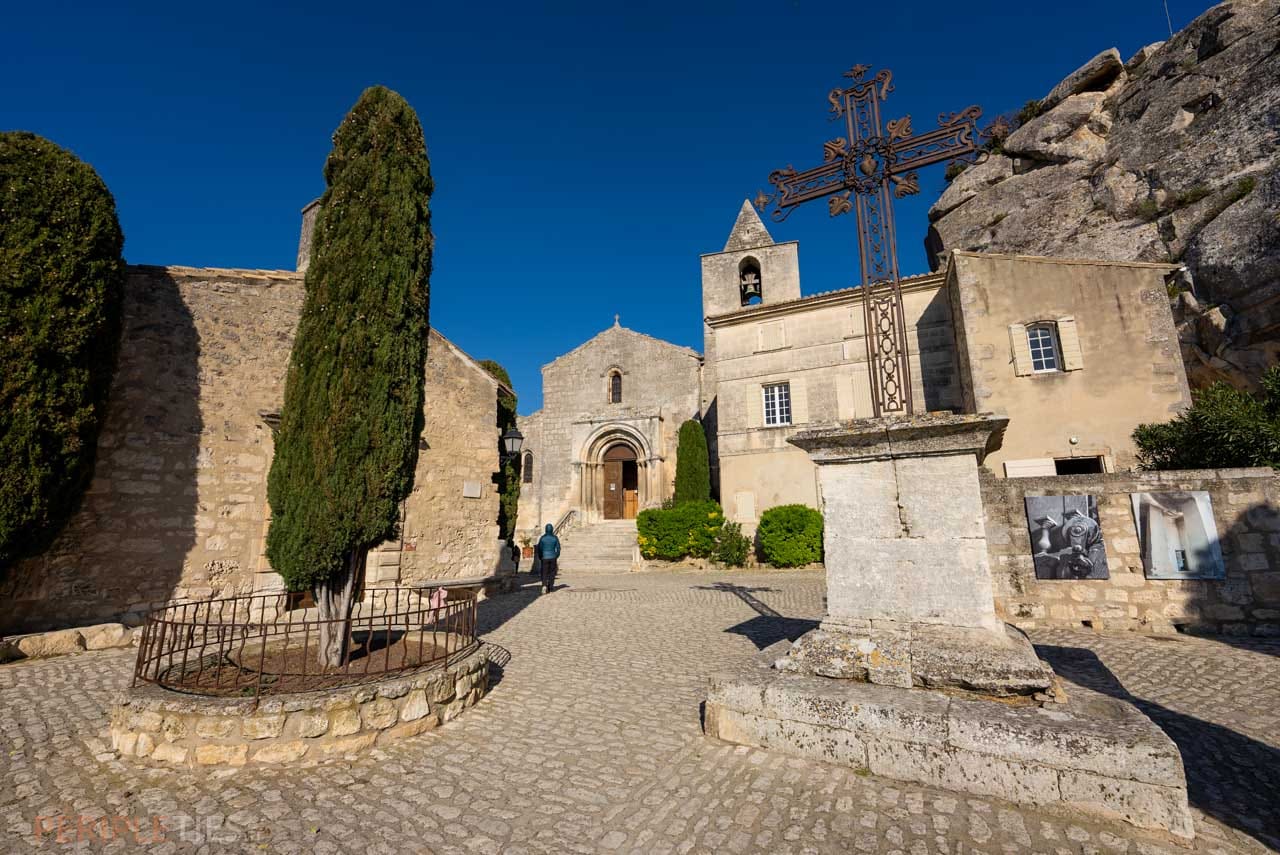
A real ‘coup de coeur’ for the Carrières de Lumières
But the real highlight of our trip was the Carrières de Lumières, just a few hundred metres from the village of Les Beaux de Provence.
It is on this former rock extraction site, which was mined until the end of the 19th century, that the paintings of the Dutch masters, from Vermeer to Van Gogh, are projected in mapping.
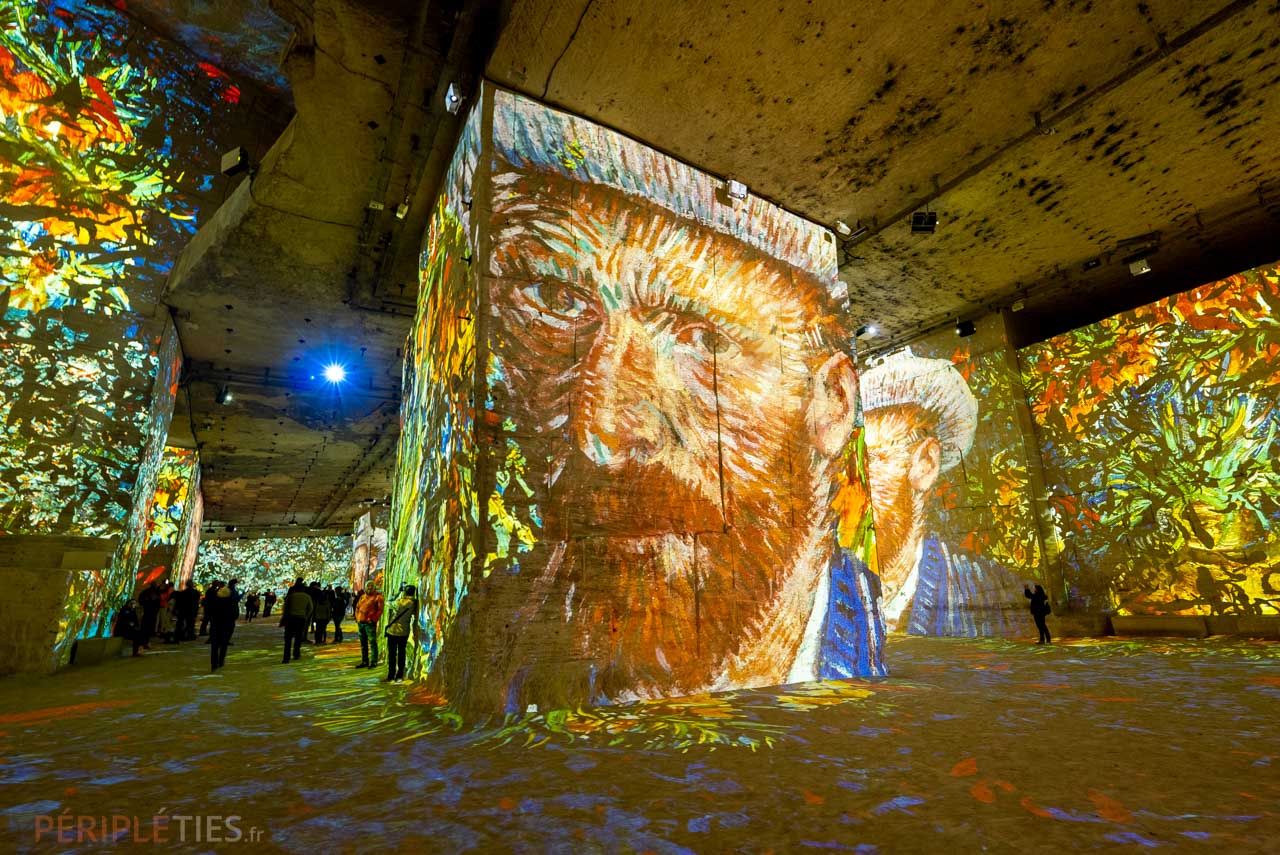
In what looks like an immense stone cathedral, you can wander among the works that come to life and play with perspective.
It's a marvellous sight, but once again, you really must visit outside weekends and school holidays, or come as soon as it opens to enjoy the show. The Carrières des Lumières has become a must-see in the region.
To visit the Carrières des Lumières in Les Baux-de-Provence, tickets cost €14.50. Shows running until 30 June 2023: From Vermeer to Van Gogh / Mondrian or Tintin, l'Aventure Immersive (afternoons only). Open from 9.30am to 7pm from April to June, until 7.30pm in July and August, and until 6pm the rest of the year.
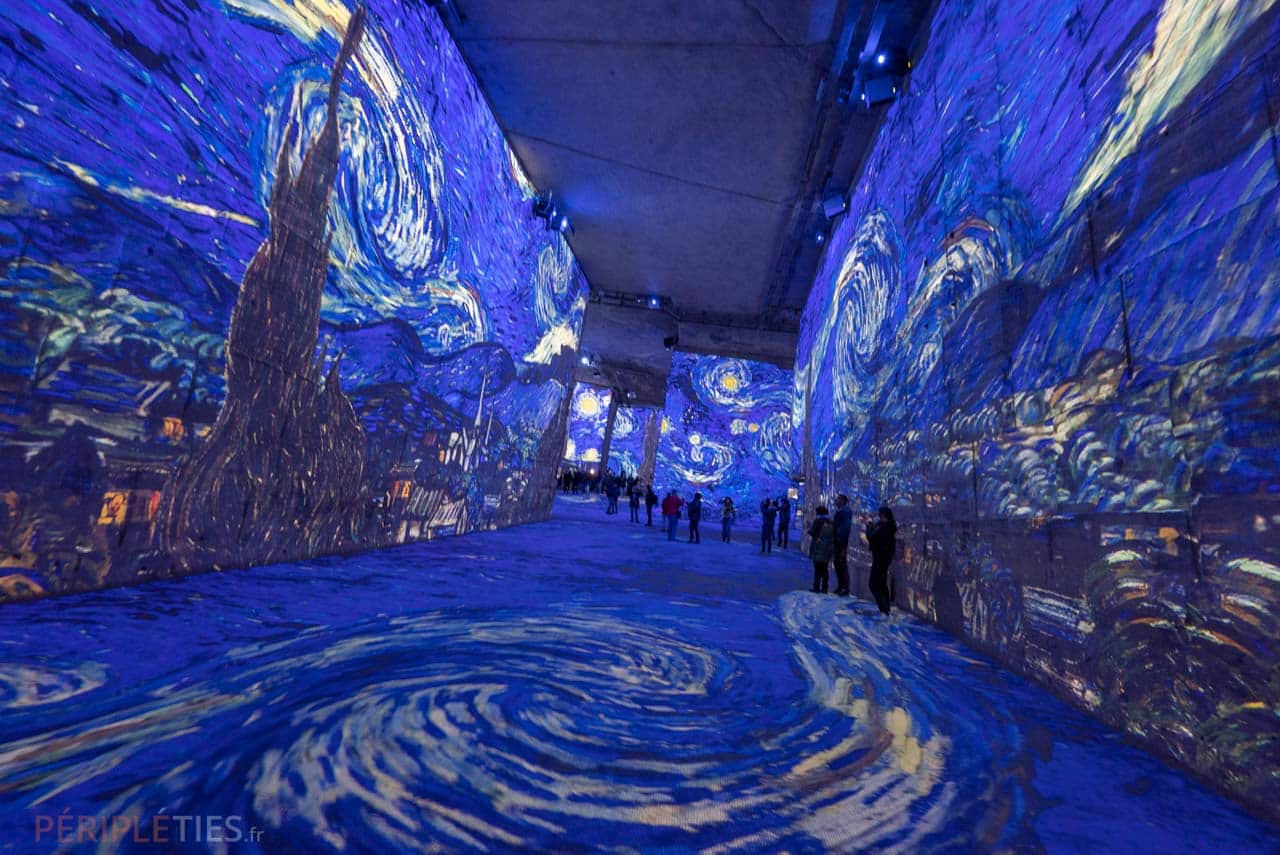
Les Baux-de-Provence, the ideal spot for family tourism in the Alpilles
With the Carrières de Lumières, the Baux fortress, the Vélorail de Fontvieille and some family walks, this area around Les Baux-de-Provence is ideal for family holidays in the Alpilles.
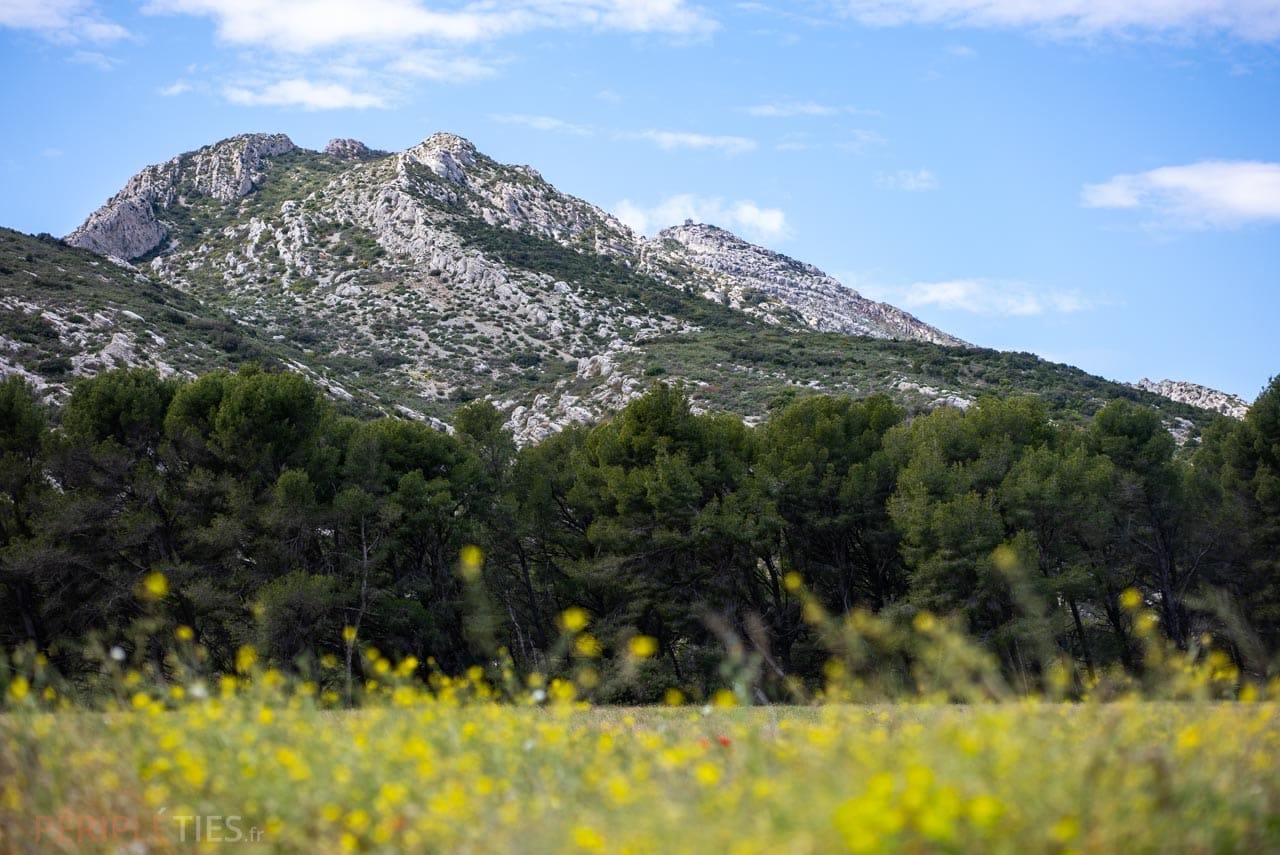
The Provencal market in Fontvieille
We continue our journey towards Fontvieille. The village is best known for its surrounding sites (Alphonse Daudet's mill, the Montauban castle, Montmajour Abbey and the Roman aqueduct at Barbegal).
But the town itself is lively and attractive, with its small square next to the market (Monday morning). In short, the kind of typically Provençal village that makes you want to sit down on a terrace (which is exactly what we did, by the way)! 😊
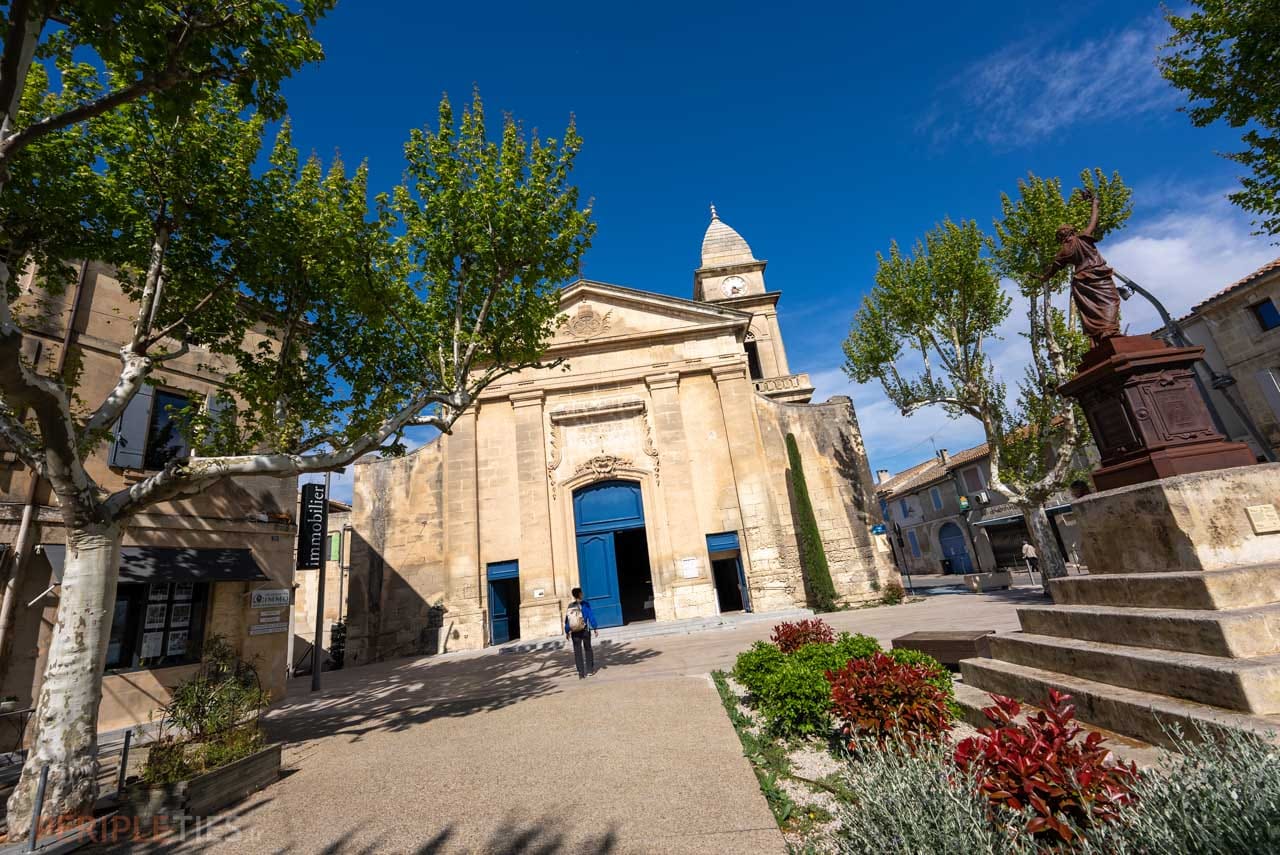
Where to walk in the Alpilles?
There's a very pleasant circular walk around and through the village of Fontvieille, following in the footsteps of the old mills in the area. It's a very easy 2.5km route (allow around an hour) through the pine forest, suitable for everyone (see route below).
What's more, you can start the walk from the Fontvieille motorhome parking and service area! 👍
Montauban castle
You'll pass by the Château de Montauban, where writer Alphonse Daudet used to stay when he left Paris to go to Fontvielle. It was here that he wrote Lettres mon Moulin, inspired by the local landscape and heritage.
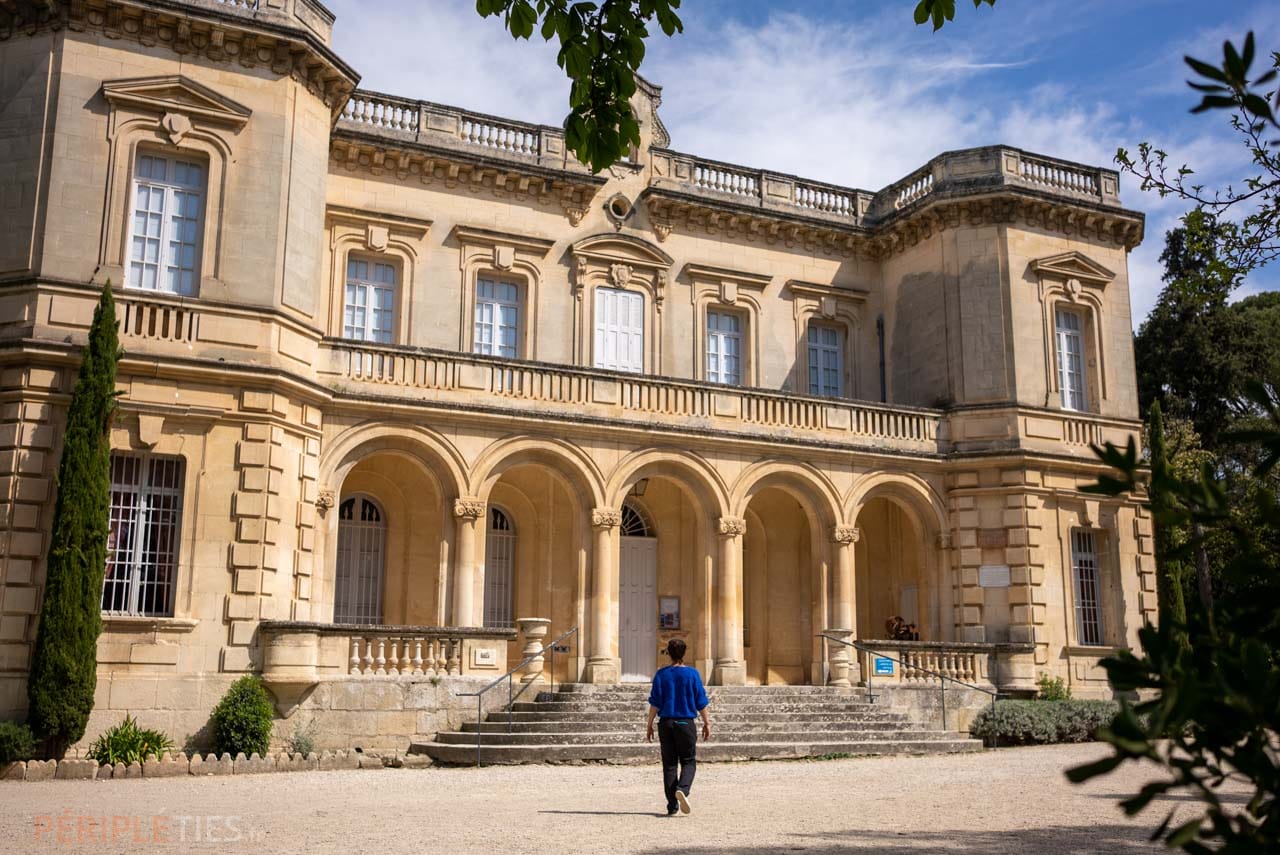
The Daudet mill
One of the old restored mills, the high point of the walk, bears the name of ‘Alphonse Daudet's mill’ (even though it never belonged to the author, contrary to his claims!) The Tissot-Avon mill, very close to the Château de Montauban, was Alphonse Daudet's favourite place to gather his thoughts.
Along the way, you can also see the Sourdon mill, the Ramet mill and the Ribet (Saint-Pierre) mill.
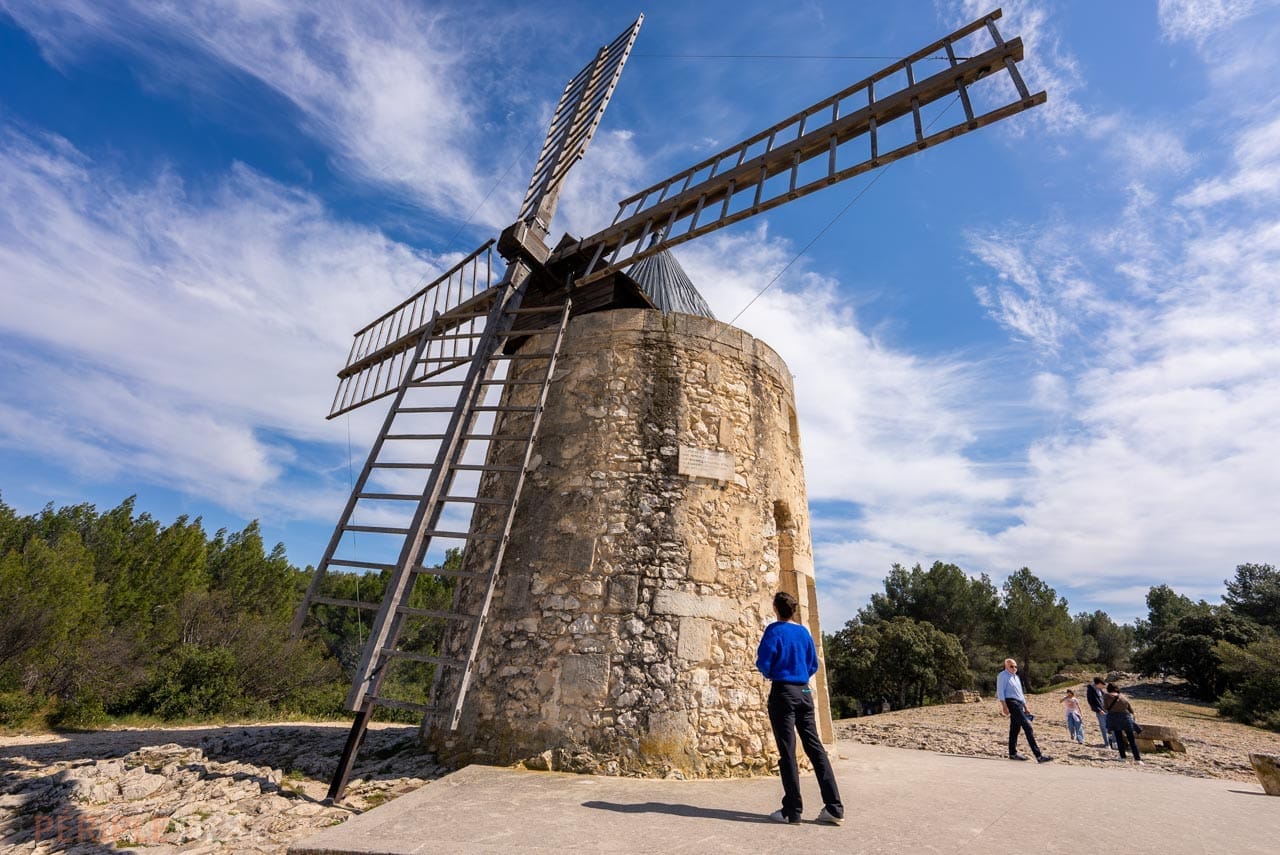
Our hike from the mills to Fontvieille (Easy – 2.5 km)
The Roman Aqueduct at Barbegal
Not far from Fontvieille, we also visited the Roman aqueduct at Barbegal, which brought drinking water to the city of Arles from the Alpilles and fed a mill.
The remains of the old aqueduct can still be seen. Even if it's not particularly exciting, it makes for a pleasant Sunday stroll!
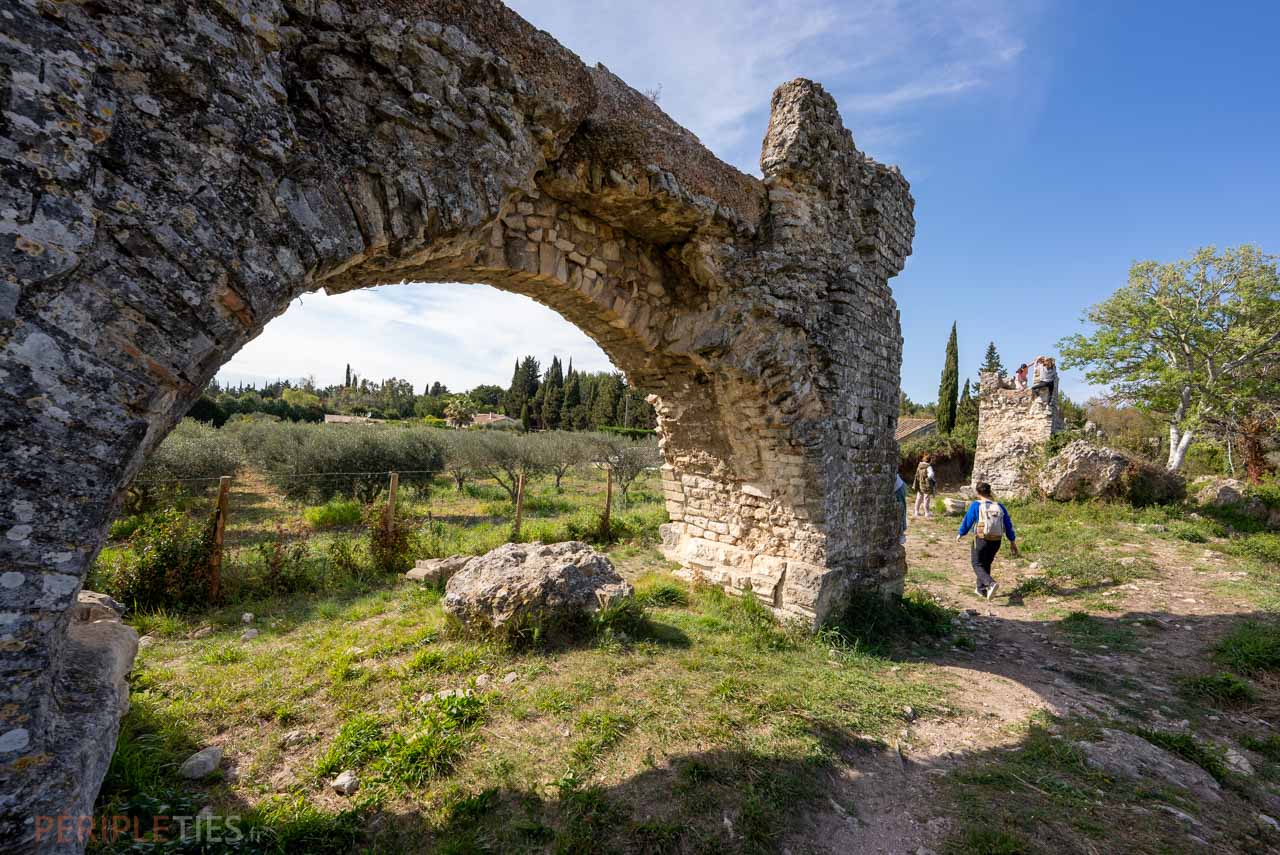
Montmajour Abbey
Montmajour Abbey, built on a rocky outcrop overlooking the plain, is another nearby tourist site that can also be a good stop-off on the way to Arles and the Camargue. Unfortunately we didn't get the chance to visit it, as the site closes relatively early.
Which is the most beautiful village in the Alpilles (for us)?
We then left the area around Fontvieille to explore the Baux valley, with its olive groves and typically Provençal villages.
The little heritage of Maussanne-les-Alpilles
First on our route, Maussane-les-Alpilles stretches along the old Roman road that linked Arles to Aix-en-Provence.
It has a pleasant square - albeit one that borders the road - and a lovely heritage to discover by getting a little lost.
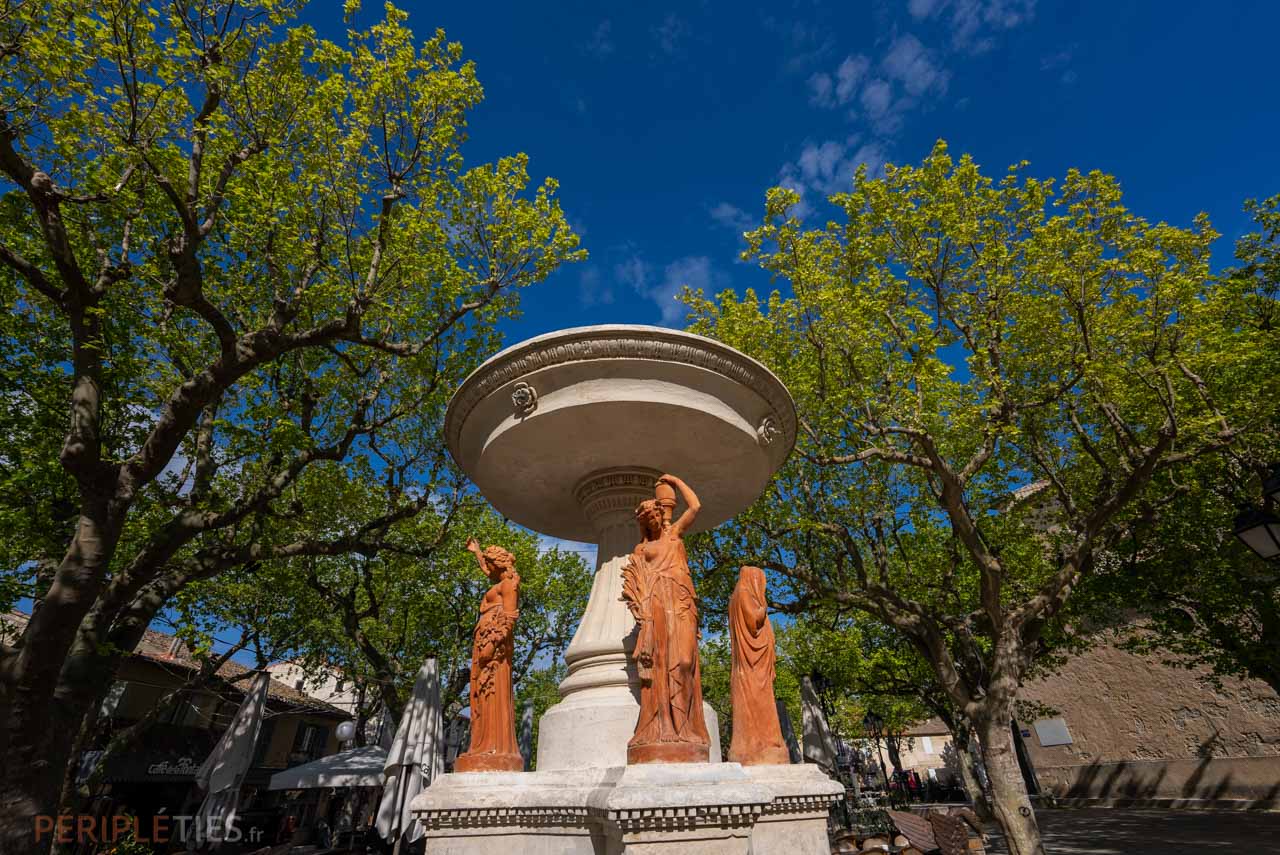
Mouriès, France's leading olive oil producer
Right next door, Mouriès, France's leading olive-growing commune (with over 90,000 olive trees) and mills still in operation, is also a great stop-off point. Don't miss a visit to a mill and an olive oil tasting session in one of these trendy villages, especially during the summer months.
If you're looking for a place to camp and sleep in your motorhome in Mouriès, Cynthia welcomes you to her 4,000 m² property surrounded by olive and holm oak trees. For tents, caravans, motorhomes, vans and vans from €10 (breakfast available for €5).
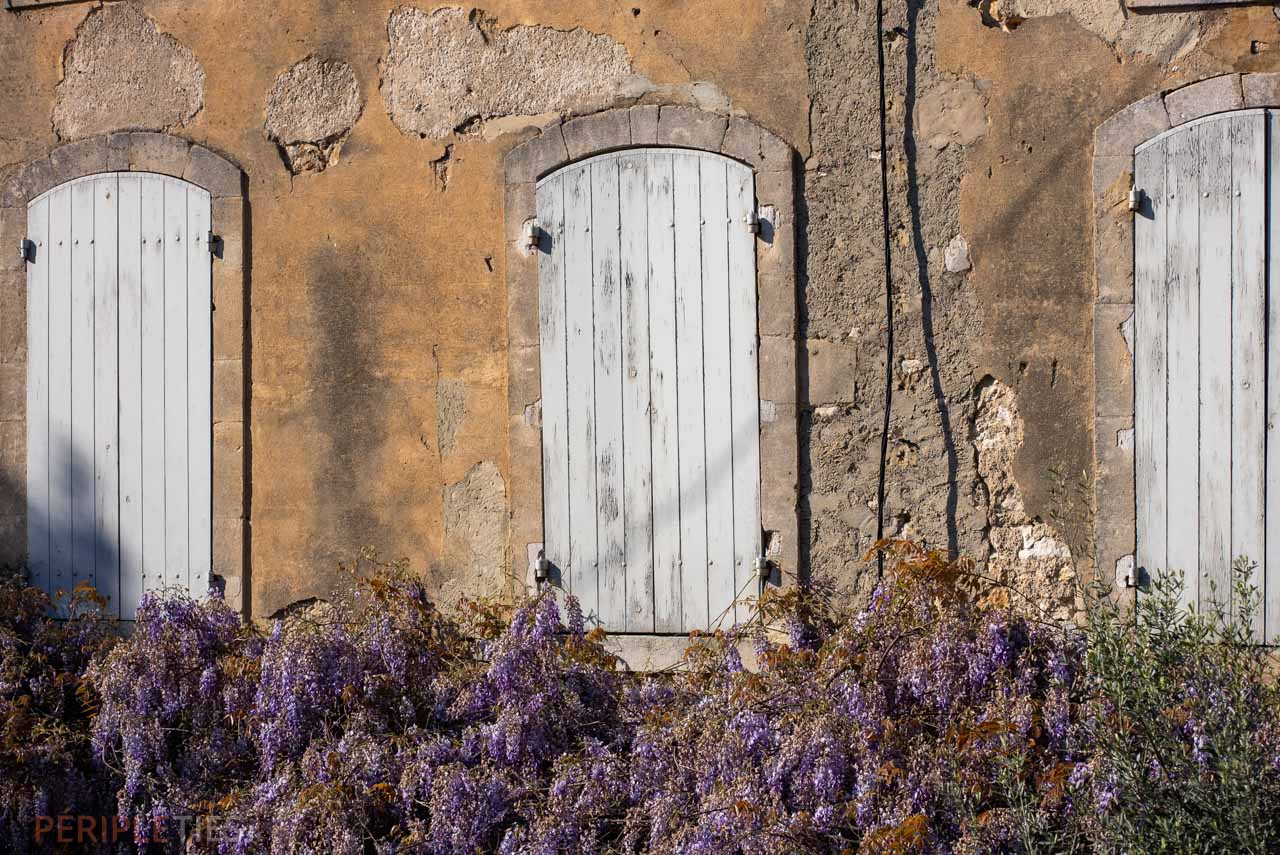
What if it was Eygalières, the most beautiful village in the Alpilles?
In our opinion, the most beautiful village in the Alpilles is Eygalières. Situated on the north-eastern slopes of the Alpilles mountain range, it offers one of the best views of the massif from the top of the village.
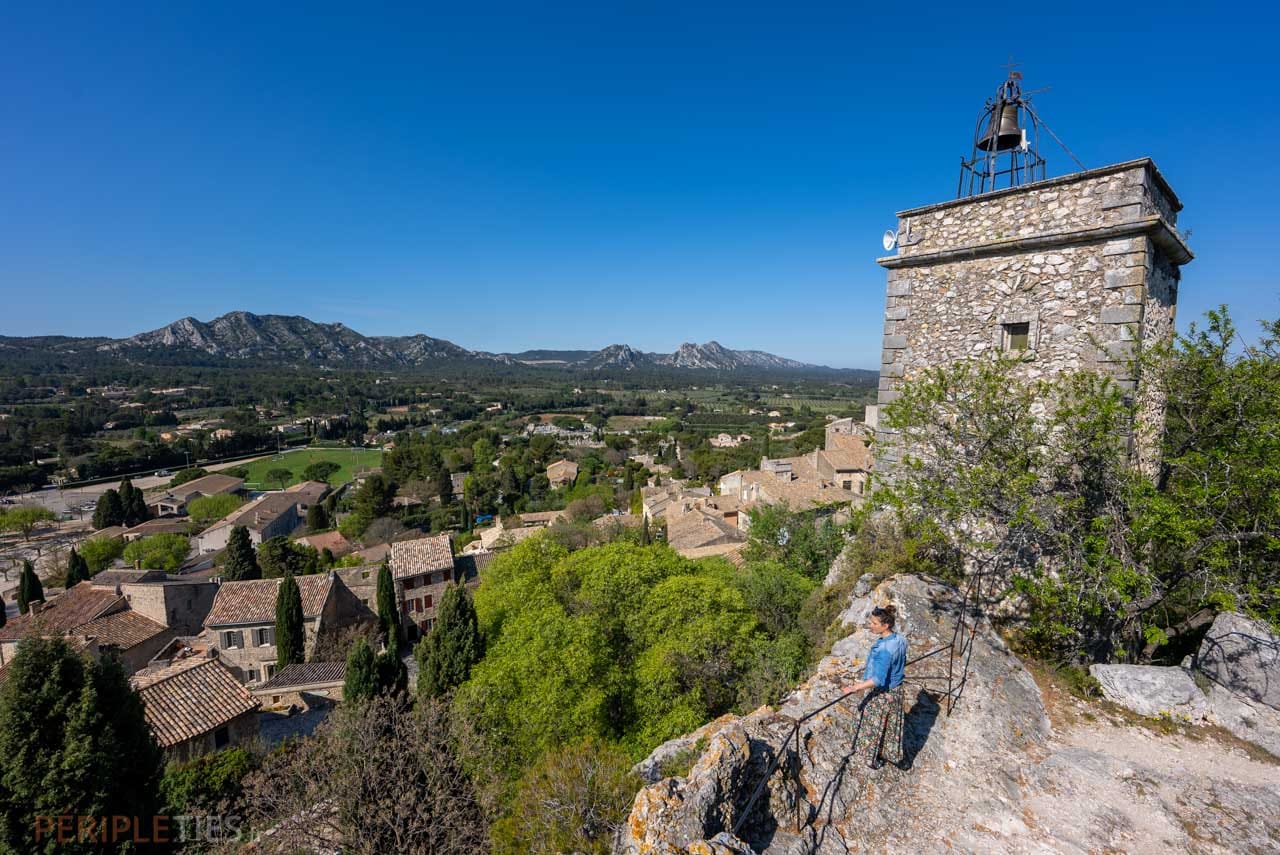
It's also an absolutely delightful village, where you can admire the facades, fountains and wash-houses or sip a drink on the terrace without being (too) bothered by the traffic.
In the surrounding area, Eygalières is a great place to hike for the highest viewpoint of the Alpilles and surrounding plains, particularly from the Tour des Opies, the highest point in the massif.
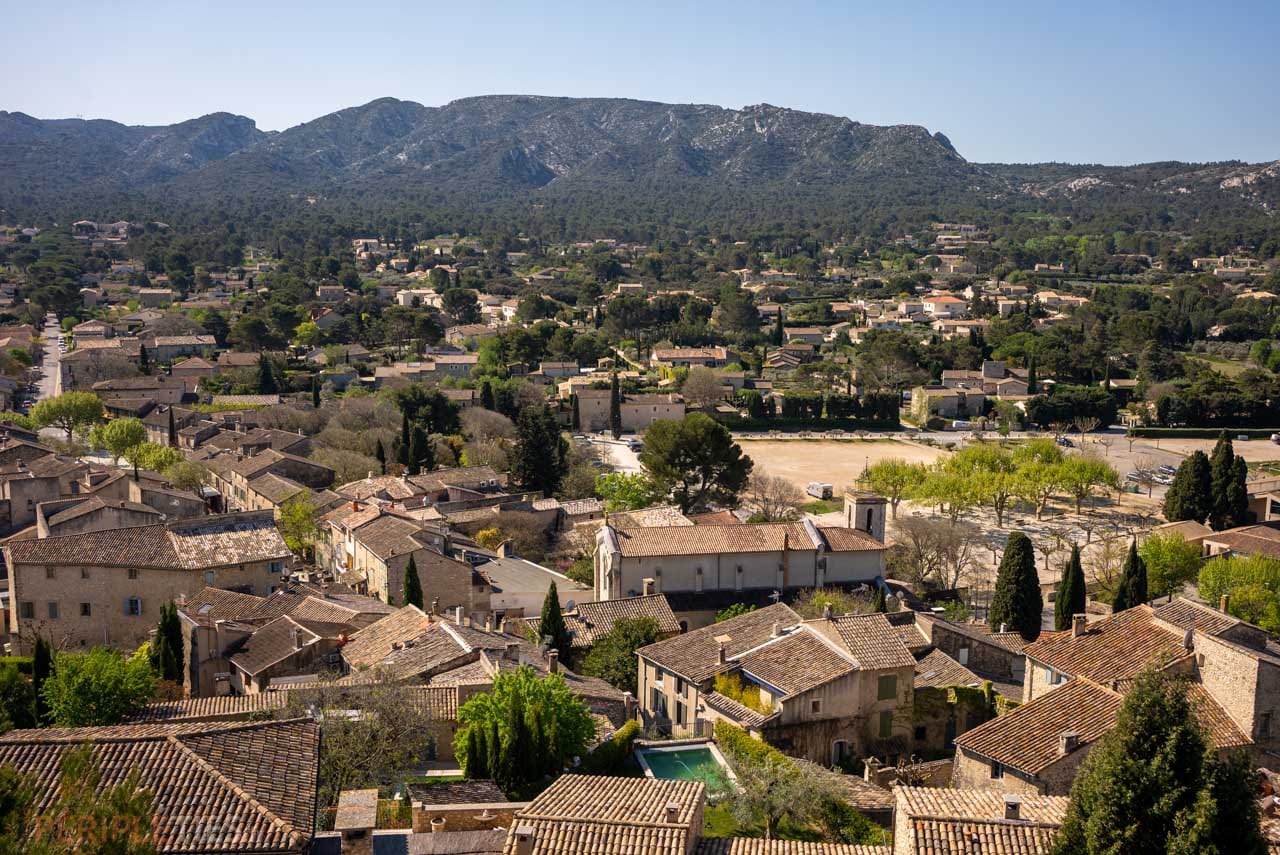
Our top 3 walks in the Alpilles
The Alpilles may be a small area, but there's no shortage of walks (everywhere) and bike rides (particularly around Saint-Rémy de Provence).
Here are the ones we've chosen, but don't forget that you can find many more routes on apps such as AllTrails or Viso Rando and on the Chemins des Parcs website and app.
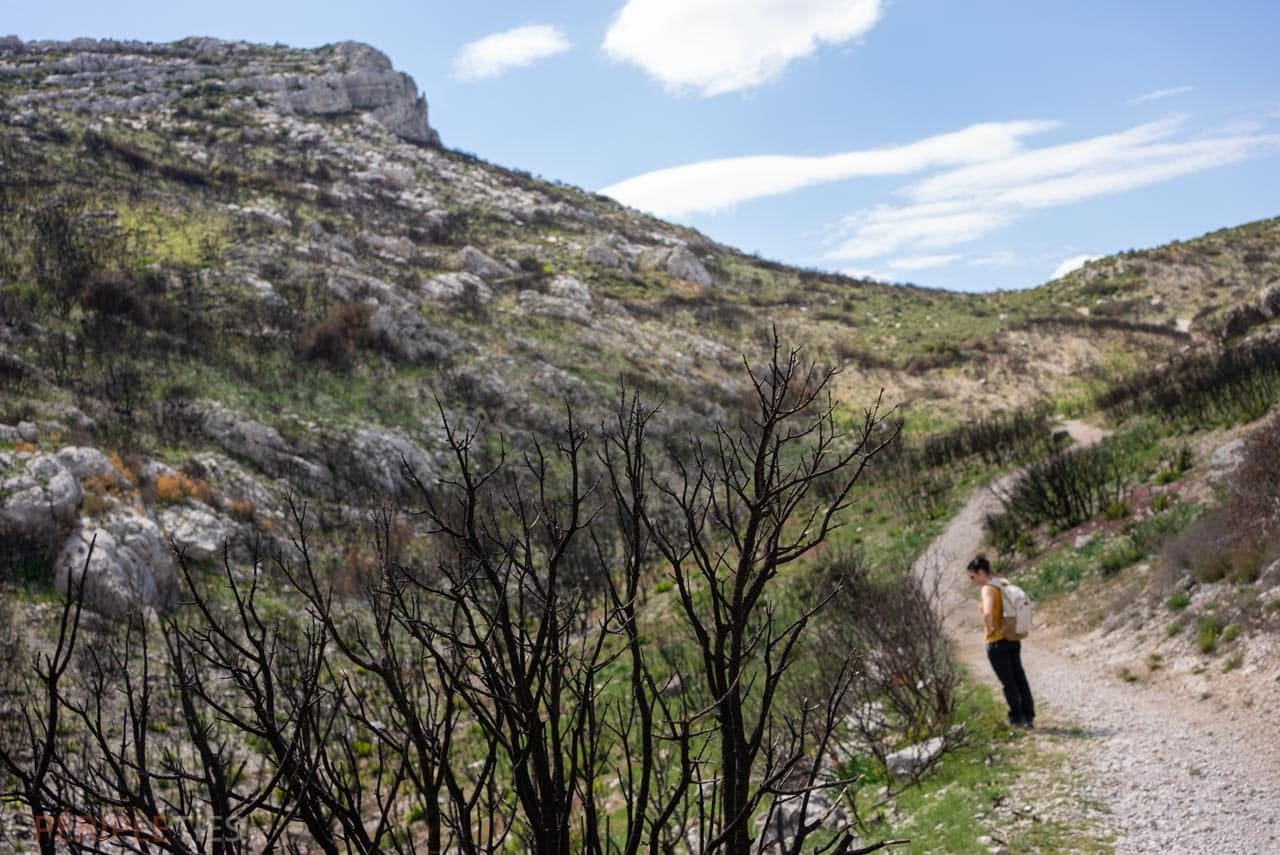
Hike no. 1: Les Caisses de Jeanjean (easy - 6 km - 1h30 - 130 m D+)
The Caisses de Jean-Jean oppidum is an archaeological site north of the commune of Mouriès.
The name of the trail alone is intriguing, isn't it? It's a legendary trail in the Alpilles (6 km - 1h30) that starts in Mouriès and leads to the Caisses de Jean-Jean oppidum, an archaeological site.
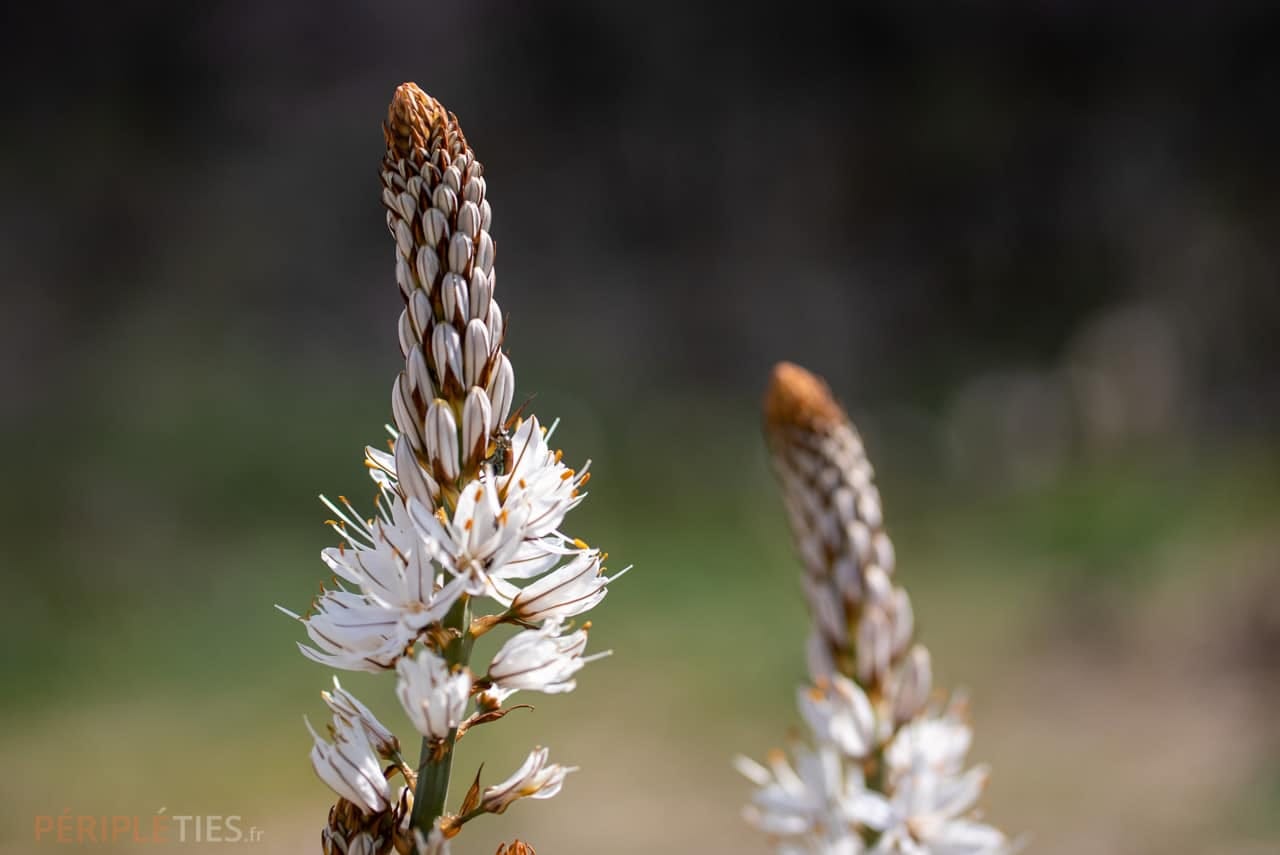
Hike n°2: La Crête des Alpilles (difficult - 16 km - 600 m D+)
If you've got the time and are a keen hiker, this hike across all the crests of the Alpilles is a great idea! It offers magnificent, varied views over the interior of the massif and the plains of Avignon and Crau.
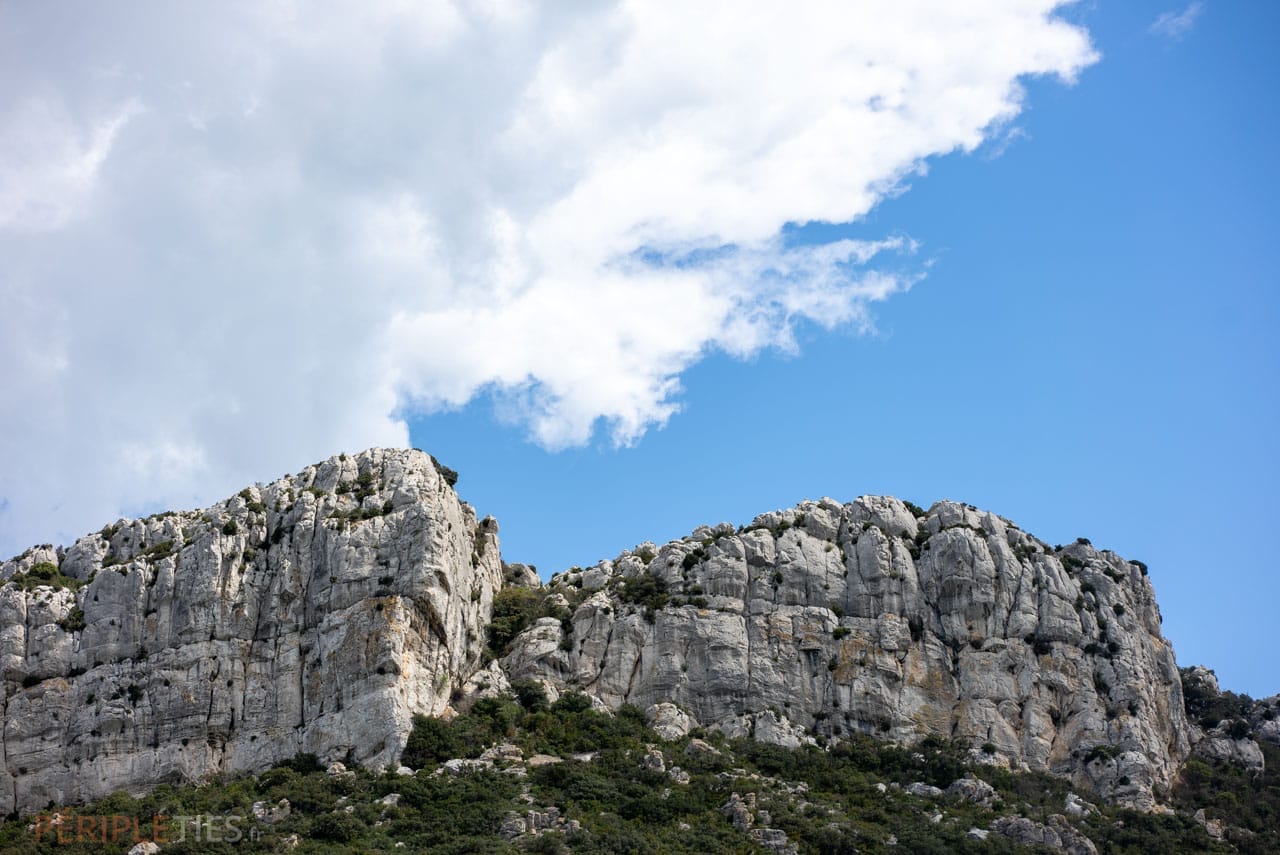
Hiking route no. 3: Tour des Opies (medium + - 8 km - 370 m D+ )
Around the village of Eygalières and through the vineyards, this is our favourite way to round off a stay in the Alpilles.
We set off on one of the hikes to the highest point in the Alpilles: La Tour des Opies (498 metres). It's a beautiful loop that climbs quite a bit, particularly in the last few metres to reach the Tower.
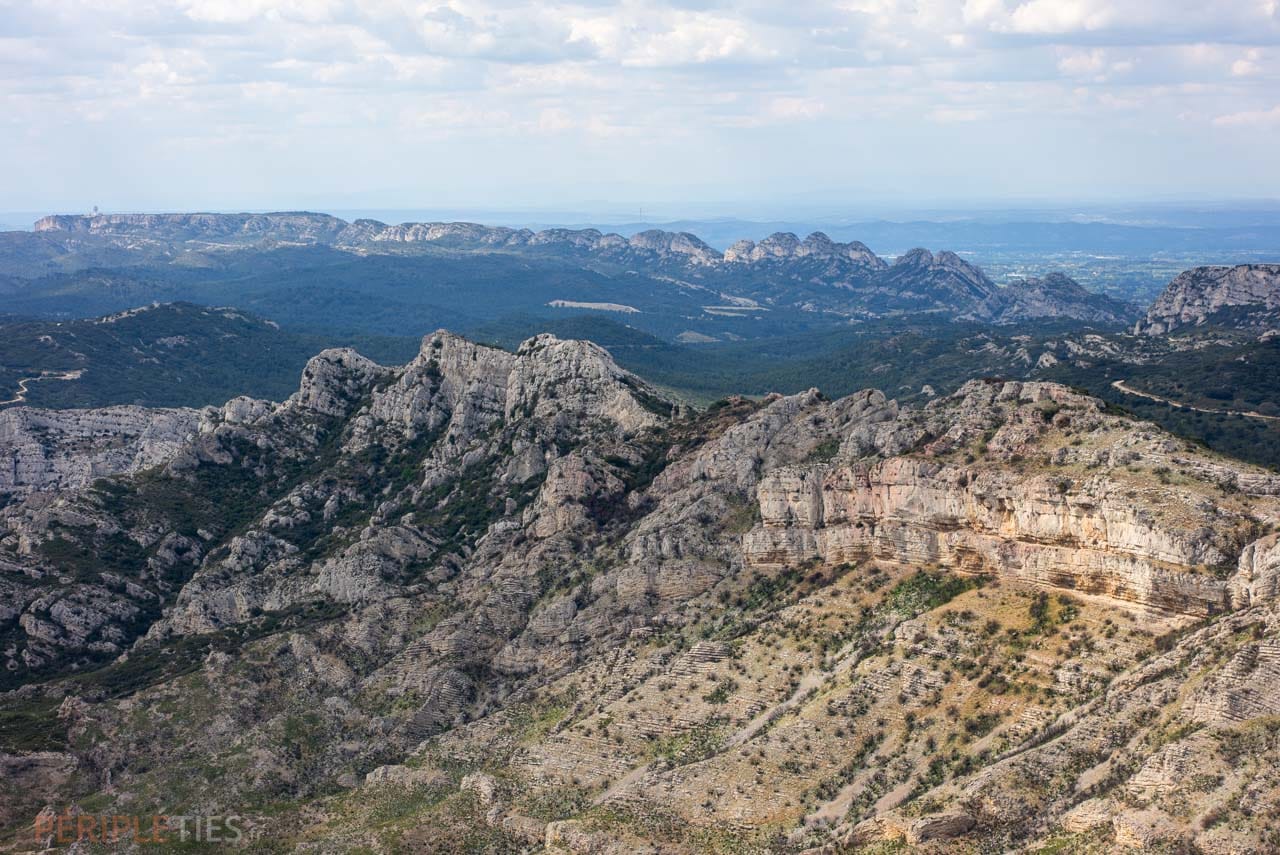
But our tenacity was rewarded! From up there, you can see the entire Alpilles mountain range and the surrounding plains.
The 360° panorama also takes in the Durance and Rhône plains, the Comtat Venaissin, the Camargue and Crau plains and the Etang de Berre... It's magical!
Our favourite hike in the Parc Naturel Régional des Alpilles (AllTrails map)
So whether you're a nature lover, a lover of local gastronomy or a fan of history and architecture, the Alpilles has it all... So don't hesitate to plan your next trip!
Pauline & Simon
